Stan Garfield's Blog, page 2
August 29, 2025
Knowledge Management Thought Leader 127: Hirotaka Takeuchi
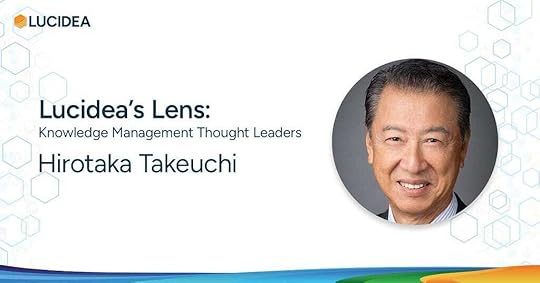
Hirotaka Takeuchi is a Professor of Management Practice in the Strategy Unit at Harvard Business School. He co-authored “The New New Product Development Game” which influenced the development of the Scrum framework. His research interests focus on the knowledge creation process within organizations, the competitiveness of Japanese firms in global industries, and the link between strategy and innovation.
In 2016, Takeuchi-san co-founded the Global Academy Corporation. The organization aims to help Japanese businesses reach their full potential by providing both offline and online learning programs to employees of member companies. His early non-academic career included work at McCann-Erickson in Tokyo and San Francisco and at McKinsey & Company in Tokyo.
Here are definitions for five of Takeuchi-san’s specialties:Agile Methodology: A way to manage a project by breaking it up into several phases. It involves constant collaboration with stakeholders and continuous improvement at every stage. Once the work begins, teams cycle through a process of planning, executing, and evaluating. Continuous collaboration is vital, both with team members and project stakeholders. Innovation : The process by which an idea is translated into a good or service for which people will pay. Knowledge Creation : Inventing new concepts, approaches, methods, techniques, products, services, and ideas that can be used for the benefit of people and organizations. Strategy : A set of guiding principles that, when communicated and adopted in the organization, generates a desired pattern of decision making. The way that people throughout the organization should make decisions and allocate resources in order accomplish key objectives. A strategy provides a clear roadmap that defines the actions people should take (and not take) and the things they should prioritize (and not prioritize) to achieve desired goals.Tacit Knowledge: Knowledge that cannot be articulated. It lives in people’s heads and is made up from individual experiences and contexts. It’s not written down and it only comes to the surface when someone asks a question.Takeuchi-san created the following content. I have curated it to represent his contributions to the field. For more about Takeuchi-san, see Profiles in Knowledge.
 Books
Books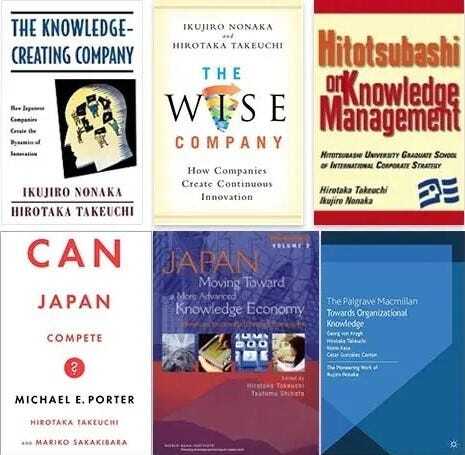 The New New Product Development Game
The New New Product Development GameLeading companies show six characteristics in managing their new product development processes:
1. Built-in Instability: Top management kicks off the development process by signaling a broad goal or a general strategic direction. It rarely hands out a clear-cut new product concept or a specific work plan. But it offers a project team a wide measure of freedom and also establishes extremely challenging goals.
2. Self-organizing Project Teams: A project team takes on a self-organizing character as it is driven to a state of “zero information” — where prior knowledge does not apply. Ambiguity and fluctuation abound in this state. Left to stew, the process begins to create its own dynamic order. The project team begins to operate like a start-up company — it takes initiatives and risks, and develops an independent agenda. At some point, the team begins to create its own concept. A group possesses a self-organizing capability when it exhibits three conditions: autonomy, self-transcendence, and cross-fertilization.
Autonomy. Headquarters’ involvement is limited to providing guidance, money, and moral support at the outset. On a day-to-day basis, top management seldom intervenes; the team is free to set its own direction. In a way, top management acts as a venture capitalist.Self-transcendence. The project teams appear to be absorbed in a never-ending quest for “the limit.” Starting with the guidelines set forth by top management, they begin to establish their own goals and keep on elevating them throughout the development process. By pursuing what appear at first to be contradictory goals, they devise ways to override the status quo and make the big discovery.Cross-fertilization. A project team consisting of members with varying functional specializations, thought processes, and behavior patterns carries out new product development. While selecting a diverse team is crucial, it isn’t until the members start to interact that cross-fertilization actually takes place.3. Overlapping Development Phases: The self-organizing character of the team produces a unique dynamic or rhythm. Although the team members start the project with different time horizons — with R&D people having the longest time horizon and production people the shortest — they all must work toward synchronizing their pace to meet deadlines. Also, while the project team starts from “zero information,” each member soon begins to share knowledge about the marketplace and the technical community. As a result, the team begins to work as a unit. At some point, the individual and the whole become inseparable. The individual’s rhythm and the group’s rhythm begin to overlap, creating a whole new pulse. This pulse serves as the driving force and moves the team forward.
4. Multilearning: Because members of the project team stay in close touch with outside sources of information, they can respond quickly to changing market conditions. Team members engage in a continual process of trial and error to narrow down the number of alternatives that they must consider. They also acquire broad knowledge and diverse skills, which help them create a versatile team capable of solving an array of problems fast. Such learning by doing manifests itself along two dimensions: across multiple levels (individual, group, and corporate) and across multiple functions. We refer to these two dimensions of learning as “multilearning.”
5. Subtle Control: Although project teams are largely on their own, they are not uncontrolled. Management establishes enough checkpoints to prevent instability, ambiguity, and tension from turning into chaos. At the same time, management avoids the kind of rigid control that impairs creativity and spontaneity. Instead, the emphasis is on “self-control,” “control through peer pressure,” and “control by love,” which collectively we call “subtle control.” Subtle control is exercised in the new product development process in seven ways:
Selecting the right people for the project team while monitoring shifts in group dynamics and adding or dropping members when necessary.Creating an open work environment.Encouraging engineers to go out into the field and listen to what customers and dealers have to say.Establishing an evaluation and reward system based on group performance.Managing the differences in rhythm throughout the development process. The rhythm is most vigorous in the early phases and tapers off toward the end.Tolerating and anticipating mistakes. The key lies in finding the mistakes early and taking steps to correct them immediately.Encouraging suppliers to become self-organizing. Involving them early during design is a step in the right direction. But the project team should refrain from telling suppliers what to do.6. Transfer of Learning: The drive to accumulate knowledge across levels and functions is only one aspect of learning. We observed an equally strong drive on the part of the project members to transfer their learning to others outside the group. Knowledge is also transmitted in the organization by converting project activities to standard practice. Naturally, companies try to institutionalize the lessons derived from their successes.
To achieve speed and flexibility, companies must manage the product development process differently. Three kinds of changes should be considered.
First, companies need to adopt a management style that can promote the process. Executives must recognize at the outset that product development seldom proceeds in a linear and static manner. It involves an iterative and dynamic process of trial and error. To manage such a process, companies must maintain a highly adaptive style.Second, a different kind of learning is required. Under the traditional approach, a highly competent group of specialists undertakes new product development. An elite group of technical experts does most of the learning. Knowledge is accumulated on an individual basis, within a narrow area of focus — what we call learning in depth. In contrast, under the new approach (in its extreme form) nonexperts undertake product development. They are encouraged to acquire the necessary knowledge and skills on the job. Unlike the experts, who cannot tolerate mistakes even 1% of the time, the nonexperts are willing to challenge the status quo. But to do so, they must accumulate knowledge from across all areas of management, across different levels of the organization, functional specializations, and even organizational boundaries. Such learning in breadth serves as the necessary condition for shared division of labor to function effectively.Third, management should assign a different mission to new product development. Most companies have treated it primarily as a generator of future revenue streams. But in some companies, new product development also acts as a catalyst to bring about change in the organization.From Knowledge to Wisdom (Chapter 1 in The Wise Company: How Companies Create Continuous Innovation)All the knowledge in the world did not prevent the collapse of the global financial system or stop institutions like Lehman Brothers and market leaders like Kodak, General Motors, and Circuit City from failing. All those failures took place at a time when knowledge has become much more abundant, free, limitless, global, open, deeper, and connected, as we mentioned in the Preface. How can that be? The problem, we find, is threefold.
First, we are not harnessing the right kind of knowledge. The two types of knowledge we identified in our first book, The Knowledge- Creating Company, are now well known: explicit knowledge and tacit knowledge. Executives tend to rely on explicit knowledge; it can be codified, measured, and generalized. Wall Street firms believe they can manage greater risk by using numbers, data, analytics, and scientific formulae instead of making judgments about loans one at a time.
The proponents of the market view the world as a test tube, in which variables can be controlled, right down to the conditions in which people live. They work from the premise of a perfectly competitive market, in which every participant has complete information and behaves with complete independence. The same kind of thinking prevails in the US automobile industry, which usually relies on offering financial incentives rather than understanding customer needs.
Dependence on explicit knowledge prevents companies from coping with change. The scientific, deductive, theory- first approach assumes a world independent of context and seeks answers that are universal. However, social phenomena — and that includes business and companies — are context dependent. Analyzing them is meaningless unless people’s subjective goals, values, and interests, as well as the interdependent relationships among them, are considered. Yet, managers fail to do that.
Second, we are not practicing what Peter Drucker espoused, namely, “making” the future. Thanks to scientific discoveries that deal with the environmental, energy, and biodiversity challenges facing the globe, and the technological advances that have helped develop smarter systems, the future is approaching faster than we have imagined.
Managers should be asking themselves: What kind of a future do we want to create? According to our novel inside- out approach to strategy, which we will discuss later in the chapter, companies differ fundamentally because they envision different futures. The specific future that a company’s top management wants to create must be based on subjective goals, beliefs, and interests. People throughout the organization should be aligned around these goals, and should be connected by their social relationships. They should share feelings, emotions, and perspectives with each other, intuitively understand the contexts facing them, and take appropriate actions.
Above all, creating the future must extend beyond the narrow interest of the company. It must be about pursuing the common good. Managers need to ask if decisions are good for society as well as for their companies; management must serve a higher purpose. Only then will companies start thinking of themselves as social entities that have been charged with a mission to create lasting benefits for society. Doing so will also recover the founding agenda of the social sciences, which is to improve the human condition.
Third, we may not be cultivating the right kind of leaders. What a novel, dynamic, and unstable world needs are “wise” leaders who can act as thinking agents of change. Such leaders will make judgments knowing that everything is contextual, will make decisions knowing that everything is changing, and will take actions knowing that everything depends on doing so in a timely fashion. They must see what is good, right, and just for society while being grounded in the details of the ever- changing front lines of business. Thus, they must pair micromanagement with big- picture aspirations about the future.
In addition, the world needs wise leaders who can resist the lure of short- termism and who understand how their companies can operate sustainably. Such leaders realize that no company will survive in the long run unless it creates a future that rivals cannot, offers more value to customers than competitors, lives in harmony with society, has a moral purpose, and pursues the common good as a way of life.
The New Dynamism of the Knowledge-Creating Company (Chapter 1 in Japan, Moving Toward a More Advanced Knowledge Economy — Volume 2: Advanced Knowledge Creating Companies)The Japanese Approach to Knowledge
Views a company as a living organism, rather than as a machineFocuses on justifying belief much more than on seeking truthEmphasizes tacit knowledge over explicit knowledgeRelies on self-organizing teams, not just existing organizational structures, to create new knowledgeTurns to middle managers to resolve contradictions between top management and front-line workersAcquires knowledge from outsiders as well as insidersTo become team leaders in the knowledge economy, middle managers must meet a number of qualifications. They need to be skilled at:
Coming up with hypotheses in order to create mid-range conceptsIntegrating various methodologies for knowledge creationEncouraging dialogue among team membersUsing metaphors and analogies in order to help others generate and articulate imaginationEngendering trust among team membersEnvisioning the future course of action based on an understanding of the pastCoordinating and managing projects.To create a knowledge spiral, a number of different conversions or syntheses need to take place. These include a conversion or synthesis across:
Tacit knowledge and explicit knowledgeLevels (individual, group, and organizational) within the companyFunctions, departments, and divisions within the companyLayers (top-management, middle manager, and front-line worker) within the companyKnowledge inside the company and knowledge outside the company created by suppliers, customers, dealers, local communities, competitors, universities, government and other stakeholdersThese synthesizing capabilities make or break the knowledge creation process.
[image error]August 22, 2025
Knowledge Management Thought Leader 126: Kent Greenes

Kent Greenes, now retired, dedicated his career to helping teams, organizations and communities unleash the power of their collective learning and knowledge. Recognized as one of the pioneers in the field of KM, his specialties are fast learning and performing, knowledge management, culture change, and transformation.
Kent worked in BP for 17 years, where he initiated and directed the Virtual Teamwork Program. He joined SAIC as their CKO in 1999 and built a highly regarded KM consulting practice in the public and private sectors. He led their business transformation and introduced Six Sigma. Kent started his own consulting practice in 2006. He led The Conference Board’s Knowledge & Collaboration and Change & Transformation Councils of cross-industry leaders.
Here are definitions for five of Kent’s specialties:
Collaboration : Interacting with peers and colleagues to exchange ideas, share experiences, work together on projects, and solve problems.Fast Learning: Learning before, during and after everything that is done. With routine comes speed, and learning with speed delivers high performance. Methods include peer assists (learning before doing), action reviews (learning while doing), and After Action Reviews (learning after doing). Culture Change : A process by which an organization encourages employees to adopt behaviors and mindsets that are consistent with the organization’s values and goals. It may be necessary to better align the behaviors of employees with current and future business objectives. Knowledge Retention : Methods of capturing or maintaining access to the knowledge of workers leaving an organization due to new jobs, retirement, promotion, relocation, and role changes; temporary work, contracting, consulting, and outsourcing; mergers, acquisitions, consolidations, and reorganizations; changes in strategy, focus, or specialty; workforce reductions; short-term job mentality; disillusionment; death, illness, and care giving.Transformation: The cultural, organizational, and operational change of an organization, industry, or ecosystem through a smart integration of digital technologies, processes, and competencies across all levels and functions in a staged and strategic way.Kent created the following content. I have curated it to represent his contributions to the field. For more about Kent, see Profiles in Knowledge.
 BookChapter 15: Knowledge Management Is about Change
BookChapter 15: Knowledge Management Is about Change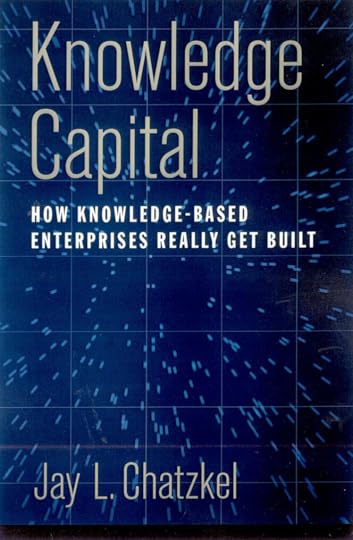 10-Step Guide to Knowledge Capture
10-Step Guide to Knowledge Capture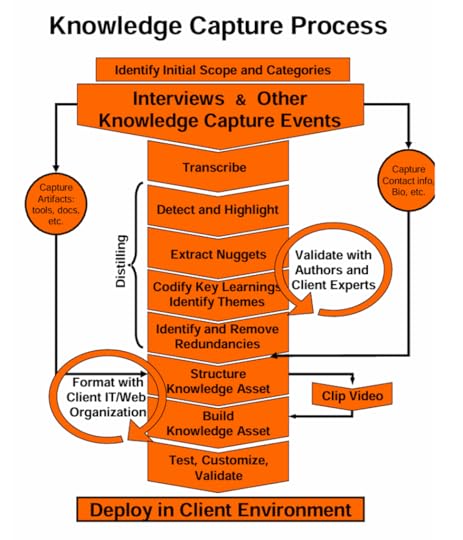 KM Roadmap
KM Roadmap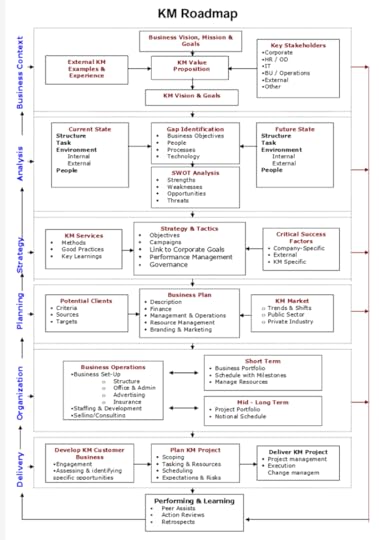 Peer Assist: Learning Before Doing
Peer Assist: Learning Before DoingHere are some critical things to do to ensure a successful outcome of a peer assist:
Define the problem or opportunity that you are facing and decide whether a peer assist is the most appropriate process.Write and disseminate a brief description of your need to peers, giving them the chance to self-select for participation.Look for diversity, that is, people who will help your team confront the problem from different perspectives.As soon as possible, identify people who can participate on your selected dates — fitting into their schedules is critical.Identify an experienced facilitator who understands the learning process.Design the event to ensure plenty of time to reflect.Allow the peer-assist team members time as a group during the session to analyze their findings.Ensure the key lessons and good practices shared during the session are captured. This may require some follow-up work to gather sufficient detail for those who did not participate.Agree to a set of actions.Make your findings accessible to others outside the group.[image error]August 16, 2025
Ana Neves: Profiles in Knowledge

This is the 118th article in the Profiles in Knowledge series featuring thought leaders in knowledge management. Ana Neves, based in Lisbon, Portugal, is the founder and managing director of Knowman (a consulting company focused on knowledge management and enterprise social networks), host of The Intranet Hub, author and host of the KMOL portal, and organizer of the Social Now conference. She is the coauthor of the Social Collaboration Maturity Benchmark and author of the biannual study on Knowledge Management in Portugal and Spain. Her specialties are knowledge management, communities of practice, organizational learning, social networks, social tools, internal communication, and cultural change management.
She was a Senior Consultant at a social business consultancy firm; Knowledge Network Manager at the NHS Modernization Agency and the Institute for Innovation and Development, both part of the British Department of Health; and Cultural Change Manager at a financial institution, leading a cultural change program for a team of 4000+ people.
In 2008, 2010 and 2011 Ana was president of the jury of the Prêmio Intranet Portal, an award that recognizes the best intranet in public and private organizations in Brazil. In 2001 she created KMOL, a Portuguese-language site dedicated to knowledge management and organizational learning.
Ana is an honorary member of the Directive Commission of the Federación Iberoamericana de Comunicación Interna (FIDECI). She has a Licenciatura (5-year Bachelor’s) degree in Computer Science from the University of Coimbra.
Through Knowman, Ana shares her experience, skills and passion with organizations looking at knowledge management, social networks, and social tools to increase their performance. She is the host of the KMOL podcast, the first Portuguese-language podcast dedicated to KM and organizational learning. Ana organizes Social Now, a unique conference on the social organization, exploring both tools and processes to improve the way organizations communicate, collaborate, learn, and share knowledge. She is responsible for Cidadania 2.0, a platform to promote examples of social tools being used to improve dialogue and civic participation.
Background EducationUniversidade de Coimbra — Licenciatura, Informatics Engineering / Computer Science, 1993–1998ExperienceKnowman — Owner and Management Consultant, 2001 — PresentStraits Knowledge — Associate Consultant, 2017 — PresentHeadshift (UK) — Senior Social Software Consultant, 2006–2009NHS Institute for Innovation and Improvement — Knowledge Management Associate, 2005–2006NHS Modernisation Agency — Knowledge Network Manager, 2002–2005Abbey National — Cultural Change Manager. 2001–2002Unisys — Consultant, 1998–2001ProfilesLinkedInKnowman — LinkedInFacebookKnowmanKMOLKMOL — FacebookSHIFT/WorkTICTeCLucidea’s LensContentSocial NowLinkedIn PostsKnowman: Knowledge, Collaboration and CommunicationNetwork ActivationNewsKMOL: Knowledge Management and Organizational LearningArticlesInterviewsBooksCasesBlogKMOL ArchiveMediumQuoraFlickrThe Intranet Hub
EducationUniversidade de Coimbra — Licenciatura, Informatics Engineering / Computer Science, 1993–1998ExperienceKnowman — Owner and Management Consultant, 2001 — PresentStraits Knowledge — Associate Consultant, 2017 — PresentHeadshift (UK) — Senior Social Software Consultant, 2006–2009NHS Institute for Innovation and Improvement — Knowledge Management Associate, 2005–2006NHS Modernisation Agency — Knowledge Network Manager, 2002–2005Abbey National — Cultural Change Manager. 2001–2002Unisys — Consultant, 1998–2001ProfilesLinkedInKnowman — LinkedInFacebookKnowmanKMOLKMOL — FacebookSHIFT/WorkTICTeCLucidea’s LensContentSocial NowLinkedIn PostsKnowman: Knowledge, Collaboration and CommunicationNetwork ActivationNewsKMOL: Knowledge Management and Organizational LearningArticlesInterviewsBooksCasesBlogKMOL ArchiveMediumQuoraFlickrThe Intranet HubA safe space for member organizations to share, view, learn, mix, and adapt from each other’s intranets.
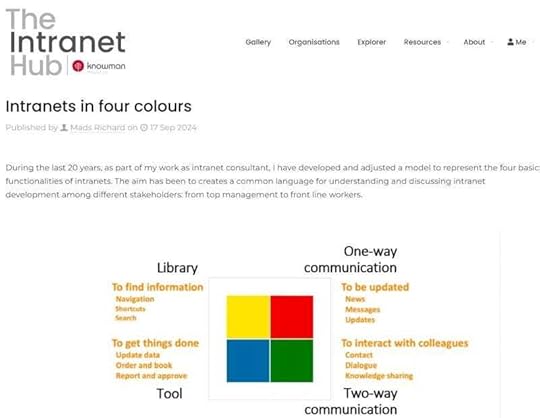 NewslettersLinkedIn — Friday Suggestions” “Things” I discover, like, or criticize, and want to share with you. Knowledge management, intranets, and the likeKMOLArticlesGestão do Conhecimento em Portugal (Knowledge Management in Portugal)The thinking behind the Knowledge Sharing Canvas design — Elium
NewslettersLinkedIn — Friday Suggestions” “Things” I discover, like, or criticize, and want to share with you. Knowledge management, intranets, and the likeKMOLArticlesGestão do Conhecimento em Portugal (Knowledge Management in Portugal)The thinking behind the Knowledge Sharing Canvas design — EliumInterviews (in Portuguese: use Google Translate to read in English) *denotes individuals I have previously profiled
Stan Garfield* (example of what Google Translate produces)Eugenio MoliníCai KjaerSumeet Gayathri MoghePatricia De Sá FreireHank MalikPaul BurnsStuart TownsendCristian SalantiCéline Schillinger*Susan Hanley*Bonnie CheukJane Mcconnell*Victoria Ward*Miguel Pina E CunhaRachel Happe*Alejandro FormanchukEdwin K. MorrisJoão BaptistaPaulo Nunes De AbreuHarold Jarche*Daria VodopianovaPaulo De CarvalhoTiago CaldasJerônimo LimaArthur Shelley*David Gurteen*Eric LynnPatrick Lambe*António AlvarengaRaphaël BrinerOscar BergLee ProvoostAlvaro CaballeroPaul Corney*Lee BryantHeitor José PereiraTheodore ZeldinRicardo SaldanhaLuis Suarez*Juliana Vale MarquesAna Neves* by Sérgio StorchEuan Semple*Roger SchankJosé António Henriques DinisSteve BorgattiNick Milton*Victor Newman (2)Geoff ParcellElizabeth Lank*Rodrigo MagalhãesKeith De La RueHubert Saint-Onge*Art Kleiner (2)Jorge Nascimento RodriguesDavid Snowden*Margaret HainesJosé Cláudio C TerraSusanne JustesenCarol Kinsey GomanPeter WestSteve BarthNancy White*Ricardo Vidigal Da SilvaVictor Newman (1)Art Kleiner (1)Thomas Stewart*Paulo Zagalo E MeloHarrison OwenPaulo N FigueiredoJosé Manuel CanavarroWendi Bukowitz E Ruth WilliamsRobert Buckman*Jessica Lipnack*Amy Jo KimEtienne Wenger-Trayner*Mark McElroyVerna Allee*What is knowledge management?Ten interviews with Portuguese-speaking KM professionals showed that knowledge management is seen and implemented very much according to the person in charge and the focus and maturity of the organization. Perhaps it would make sense to have a single definition of knowledge management. At the same time, if we can adapt our approach to knowledge management according to the organization’s pains, priorities, culture, and maturity, we may get more traction for our efforts and, consequently, better results.
Read these ten definitions and perspectives. Think about which ones might make the most sense in your organization, challenge yourself to discover angles you’re not yet exploring, and identify interesting arguments to use. If your activity is related to knowledge management or if you would like to find arguments to improve knowledge management in your organization, do yourself a favor and go listen to the ten interviews. Believe me, you won’t regret it!
Data to Knowledge to Innovation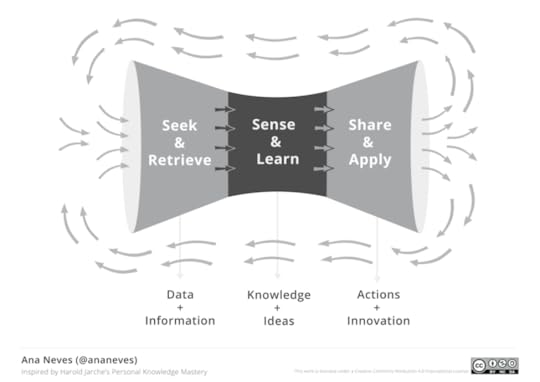
Willingly or not, an organization is constantly producing and receiving data from internal and external sources. In turn, information may be sourced or produced by analyzing available data. Data and information are key. Organizations ought to be aware of the data and information they have and need.
Organizations should then:
Identify and characterize their existing sources — for instance, if they are dependable, their associated costs, and the impact of losing them.Understand who uses the available data and information and whether it could be used by other parts of the organization.Assess the impact of not having the data and information they need.Identify ways of sourcing the data and information required.Based on this assessment the organization can go on to procure what is missing, manage what is available, and explore that available data and information for business gains (efficiency, market, etc.). The model depicts additional aspects of the data-knowledge-innovation relationship:
Making sense of data and information will generate learning and, consequently, the creation of knowledge.New ideas emerge from knowledge, especially from knowledge in the interception of different knowledge domains.New ideas are evaluated and implemented according to existing knowledge, data and information.Innovation is the successful implementation of new ideas and, hence, one way of applying knowledge.The product of innovation is both a way of sharing knowledge and a new source of data and information that feeds back into the organization.Knowledge may be used to create actionable insights which then lead to actions.Sharing and applying knowledge, in the shape of actions or innovation, creates value for the organization and its stakeholders.Why Social Tools are Like Sauces
I love sauces. Sauces are great. People usually love sauces. Ketchup, mayo, soy, white, vinaigrette, etc. Some interesting facts about sauces:
they complement and enhance food’s flavorwe don’t really have sauce on its ownnot every sauce goes well with every mealunless you are a food specialist, you know if a sauce tastes nice with your meal but you would not know which sauce to choose to go with it (color, consistency, flavor-wise).Now that I have said this, and bearing in mind the title of this post, you have probably guessed where I am going with this 😊. Yes, I do think that these facts also apply to social tools (in the enterprise). Let’s consider one at a time.
Social tools can complement and enhance organizational processes. Identifying a colleague who has worked on a similar project as mine, becomes easier. Integrating new colleagues may be quicker and become a more pleasant experience for all involved. Despite that, having a tool without associated processes and practices means nothing. We do not buy tools for the sake of buying tools. We buy tools because we expect them to improve the way we work.
Not all social tools are appropriate for all organizations. As I usually say, find a tool that can stretch your organization in the direction it wants to go, but which does not stretch it to the point that staff feels threatened by it.
Choosing a tool involves looking at things from different angles: technical, business and user experience. Does the tool fit in nicely with other existing tools? Is it easy to administer? Can it adapt to our processes? Will the processes it supports help our organization? Is it easy and intuitive for our staff? When all these things are considered and accounted for, tools can really make a difference. Maybe you would not be able to choose it on your own, but you know it is good when you try it.
A sauce is usually less expensive than a social tool for the organization. And I say usually because there are some free or very low cost tools (I will be suggesting some next week in Seville). However, the cost of choosing the wrong tool is extremely higher than choosing the wrong sauce. Choosing the wrong tool means hours of work (installation, set up, training, roll out) down the drain. It usually means a decrease in people’s faith in these tools which, in turn, maps into a much slower adoption curve for any tool that follows.
Choosing a social tool is an important decision that should not be taken lightly. Take time to consider the different angles. To help you choose the best sauce… oops!, social tool to spice up your organization I conceived an event with a unique format. Check out the video below to understand what is unique about Social Now. And then, if you are interested, please visit the event’s site.
Social Now — Why is it unique?https://medium.com/media/08a3757301a9a8a4cf3bd711382d07c7/hrefArticles by Othersknowledge et al — Paul CorneyWhat is the right culture for your organization? — Jack VinsonThe Right Organizational Culture: A Requirement?Sector Dialogues. Interview: Ana Neves. Citizens demand better digital communication channels, faster services and more transparencyNew ways of working doesn’t just mean new tools — Gloria LombardiSIKM Leaders CommunityPostsScheduled to present on June 16, 2026SlideShareEffective Project Management using Social TechnologiesEffective Project Management using Social Technologies
Communicating with a Knowledge HatCommunicating with a Knowledge Hat
Why and How to use Communities of PracticeWhy and How to use Communities of Practice
PodcastsKMOLKMOL — YouTubeBecause You Need To KnowBYNTK 2Narratives of Work: Social Collaborations in Organizations with Jaap LinssenYou’ve got cash just laying around your workplace: The Digital WorkplaceSharing and Retaining Knowledge in Your Organization: Virtual not DistantVideosKnowmanA quick tour of The Intranet Hubhttps://medium.com/media/93d5a22e5957ea80b397bba96387be70/hrefHow to create an effective digital workplacehttps://medium.com/media/77595b9a579f91be8b20e12ef2c4b8b8/hrefCommunities of Practicehttps://medium.com/media/cfe0ac7a96993f581ea46b80ad4e823f/hrefEffective Project Management using Social Technologieshttps://medium.com/media/93bb820c40c83761a32ad5f0cffd1387/hrefAna Neves explains why she created Social Nowhttps://medium.com/media/ac1ad7fd66b30a3894024de80ba77091/hrefWhy People Don’t Share Knowledgehttps://medium.com/media/32929bc910a07894fa7f80259b363069/hrefVisualizing Knowledge Networks & Social Interactionshttps://medium.com/media/467ade0865efd73faee9dd4f5b0daaea/hrefFrom top to bottom or bottom to top: approaches and geographieshttps://medium.com/media/b3649978fc6e153874ca03ba9829be89/hrefTICTeC 2018 — Two heads are better than one: working with governmentshttps://medium.com/media/4ed00718294d644b624c4f47517661ea/hrefBooksGaining Buy-In for KMEdited by Laura Slater, with Nick Milton, Stan Garfield, Bill Kaplan, Ian Fry, Keith Power, Michel J. Boustani, Gavin Ireland, Simon Yelsky, and Paul McDowallAna Neves is a chapter author in a recent Ark Group publicationChapter 8: No pain and a lot to gainCase study: Cablinc engineersCase study: Public sectorCase study: A private bank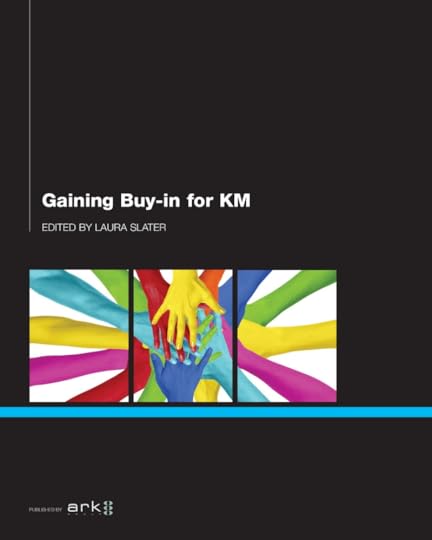 Knowledge Management Tools: Main Selection CriteriaKnowman collaborates in the creation of a guide for the selection of KM tools
Knowledge Management Tools: Main Selection CriteriaKnowman collaborates in the creation of a guide for the selection of KM tools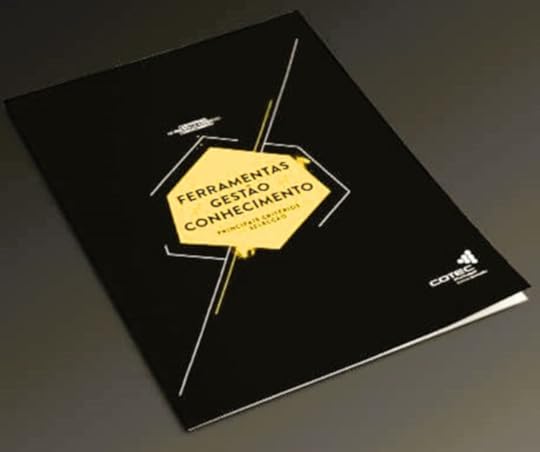 It Can Be Done: Knowledge Management and Innovation in the Public Sector
It Can Be Done: Knowledge Management and Innovation in the Public Sector Profiles in Knowledge: 120 Thought Leaders in Knowledge management by Stan Garfield
Profiles in Knowledge: 120 Thought Leaders in Knowledge management by Stan Garfield [image error]
[image error]
August 15, 2025
Knowledge Management Thought Leader 125: Göran Roos
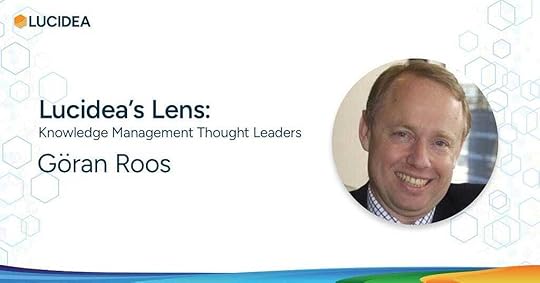
Göran Roos, originally from Sweden, now lives in England. He was co-founder of Intellectual Capital Services Ltd. (ICS), a London-based strategy consulting firm and think tank in the fields of innovation management, value measurement, strategy and management of intellectual capital, and strategic learning experiences. Göran is a pioneer in the intellectual capital movement
He is the prolific author and co-author of over three hundred books, book chapters, papers, and articles on Intellectual Capital, Innovation Management, Strategy, and Industrial Policy, many of which have been recognized with awards. He has around 14,000 Google Scholar citations. His specialties include strategy; innovation management; and industrial, innovation and research policy.
Here are definitions for five of Göran’s specialties: Innovation : The process by which an idea is translated into a good or service for which people will pay. Intellectual capital : The sum of everything everybody in a company knows that gives it a competitive edge. A metric for the value of intellectual capital is the amount by which the enterprise value of a firm exceeds the value of its tangible (physical and financial) assets. It includes human, structural, and relational capital.Research: Creative and systematic work undertaken to increase the stock of knowledge. It involves the collection, organization, and analysis of information to increase understanding of a topic or issue. Strategy : A set of guiding principles that, when communicated and adopted in the organization, generates a desired pattern of decision-making. The way that people throughout the organization should make decisions and allocate resources to accomplish key objectives. A strategy provides a clear roadmap that defines the actions people should take (and not take) and the things they should prioritize (and not prioritize) to achieve desired goals.Value measurement: The process of quantifying the benefits of a product, service, or business component to assess its contribution to overall organizational objectives.Göran created the following content. I have curated it to represent his contributions to the field. For more about Göran, see Profiles in Knowledge.
Books by Göran Roos Evaluating Intellectual Capital and Measuring Knowledge Management Effectiveness
Evaluating Intellectual Capital and Measuring Knowledge Management Effectiveness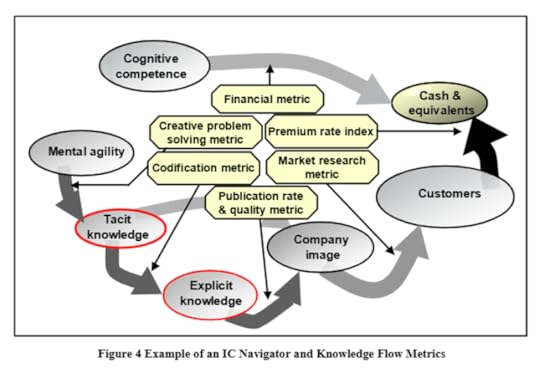
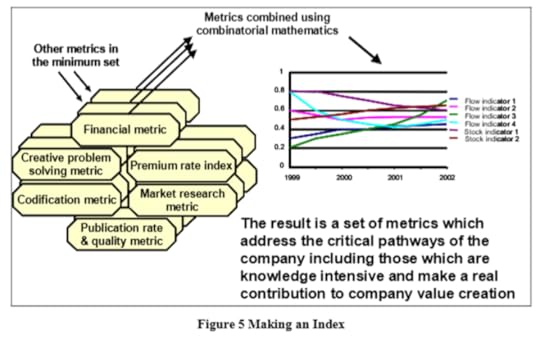 Intellectual Capital and Knowledge Management Effectiveness
Intellectual Capital and Knowledge Management Effectiveness
Three cognitive distinctions of knowledge creation
Cognitivist — Cognitivists consider the identification, collection and central dissemination of information as the main knowledge development activity. Organizations are considered as open organizations that develop increasingly accurate pictures of their pre-defined worlds through the assimilation of new information. Knowledge is developed according to universal rule, hence the context of the incoming information is important.Connectionist — There are many similarities here to the cognitivist viewpoint but a difference being that there are no universal rules. As rules are team-based and vary locally, organizations are seen as groups of self-organized networks dependent on communication. The connectionists believe that knowledge resides in the connections and hence focus on the self-organized dispersed information flow.Autopoietic — Here the context of information inputs is unimportant; it is seen as data only. The organization is a system that is simultaneously open (to data) and closed (to information and knowledge). Information and knowledge cannot be transmitted easily since they require internal interpretation within the system according to the individual’s rules. Thus autopoietics develop individual knowledge, and respect that process in others.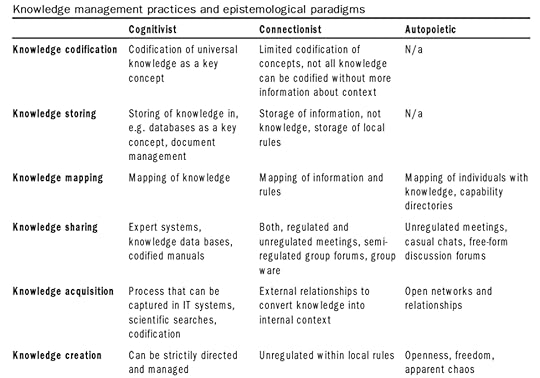 Measuring the Impact of Knowledge Management in Companies
Measuring the Impact of Knowledge Management in CompaniesMax Boisot’s 6-step social learning cycle. The steps are scanning, problem solving, abstraction, dissemination, absorption, and impacting and are shown below.
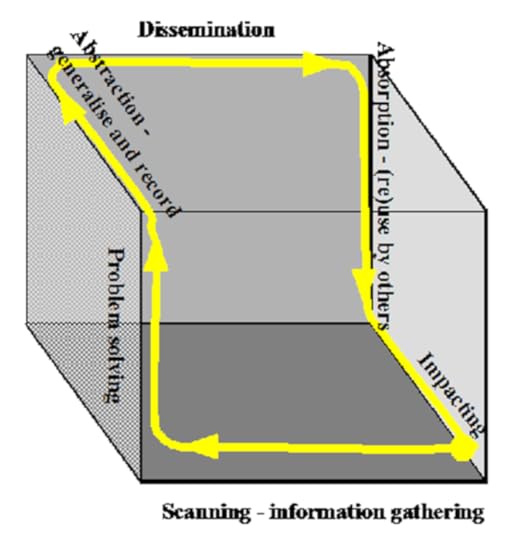
Conceptual map generated by the ICS Navigator process. The size of the oval represents the importance of the static resource while the thickness of the arrow represents the importance of the transformations between the resources.
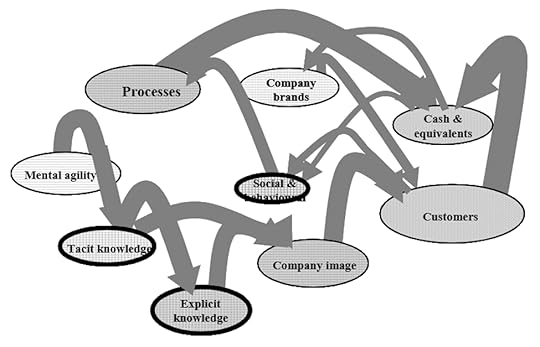 [image error]
[image error]
August 10, 2025
Knowledge Management Thought Leader 124: Hazel Hall

Hazel Hall is an Emeritus Professor in the School of Computing, Engineering, and the Built Environment (SCEBE) at Edinburgh Napier University UK, and Docent of Information Studies in the School of Business and Economics at Åbo Akademi, Finland. She is a Fellow of the Royal Society of Edinburgh.
Her main research expertise and teaching interests are information sharing in online environments, within the context of knowledge management. Other interests include information behavior and use, online communities and collaboration, library and information science research, and research impact. Hazel’s doctoral thesis considered the role of intranets in knowledge sharing.
Here are definitions for five of Hazel’s specialties:
Communities : Groups of people who share an interest, a specialty, a role, a concern, a set of problems, or a passion for a specific topic. Community members deepen their understanding by interacting on an ongoing basis, asking and answering questions, sharing their knowledge, reusing good ideas, and solving problems for one another. Intranets : Private computer networks that use Internet protocols, network connectivity, and the public telecommunication system to securely share part of an organization’s information or operations with its employees. Motivation : The process that initiates, guides, and maintains goal-oriented behaviors. Why a person does something, involving the biological, emotional, social, and cognitive forces that activate behavior.Research: Creative and systematic work undertaken to increase the stock of knowledge. It involves the collection, organization, and analysis of information to increase understanding of a topic or issue. Tacit knowledge : The implicit, unwritten, and often hard-to-articulate knowledge that an individual gains through experience. It is the “know-how” that is difficult to explain or codify, often involving intuition, skills, and contextual understanding. Unlike explicit knowledge, which can be readily written down or communicated through formal means, tacit knowledge is deeply personal and rooted in practice.Hazel created the following content. I have curated it to represent her contributions to the field. For more about Hazel, see Profiles in Knowledge.
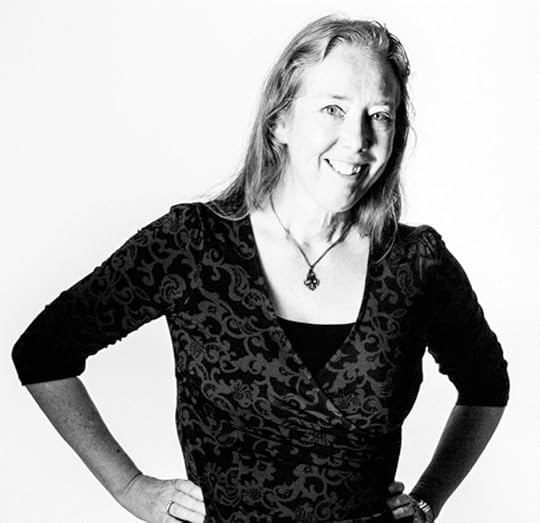 Books by Hazel Hall
Books by Hazel Hall
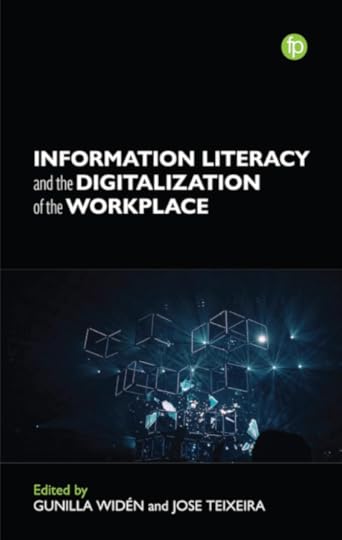 Social Exchange for Knowledge Exchange
Social Exchange for Knowledge Exchange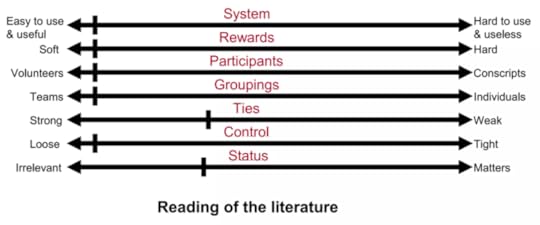
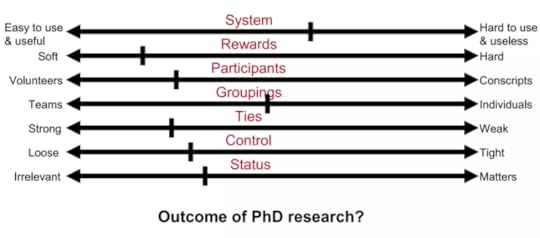 Tacit Knowledge Sharing in Online Environments
Tacit Knowledge Sharing in Online Environments Knowledge Management and Knowledge Sharing
Knowledge Management and Knowledge Sharing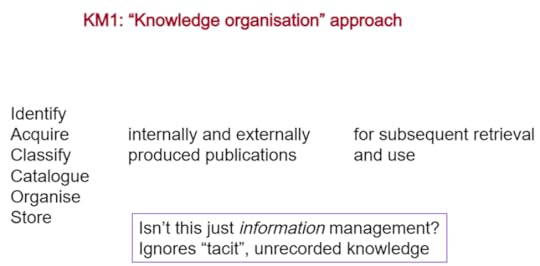
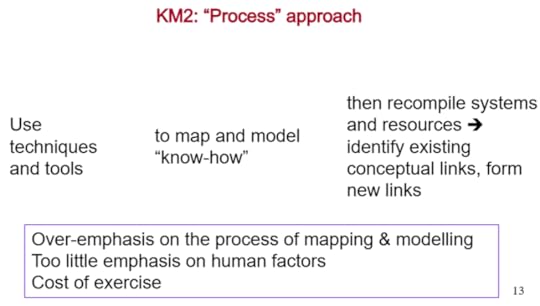
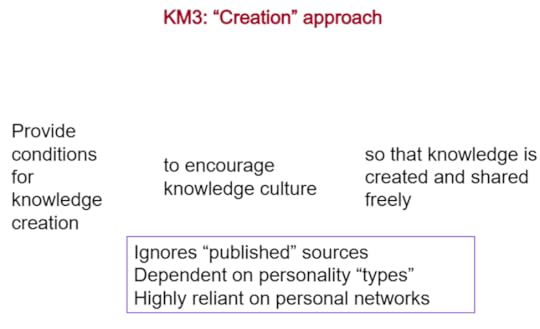 [image error]
[image error]
August 1, 2025
Knowledge Management Thought Leader 123: Ikujiro Nonaka
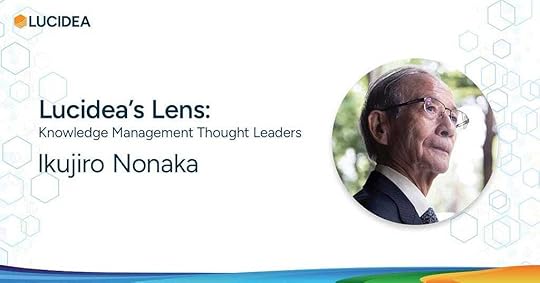
The late Ikujiro Nonaka was a Japanese organizational theorist and Professor Emeritus at the Graduate School of International Corporate Strategy of the Hitotsubashi University. He was a pioneer in creating the field of knowledge management and studying the impact of knowledge creation on product development and innovation.
Nonaka-san’s primary research interest was to establish and disseminate the theory of knowledge-based management of companies, communities, public administration, and the nations, in order to facilitate ongoing, sustainable knowledge creation and innovation. As part of this work, he conducted comparative research on leaders and on knowledge-creating processes in companies and organizations, and of leaders, around the world. Accordingly, he was known globally as the ‘guru’ of Knowledge-based Management, having proposed concepts and theories on organizational knowledge creation processes and leadership since the 1980s.
His academic works included the SECI Model for the organizational knowledge creating process, the concept of Ba and the dynamic model of organizational knowledge creation process, the concept and abilities of wise leadership and phronesis (practical wisdom), and historical imagination and idealistic pragmatism.
Here are definitions for five of Nonaka-san’s specialtiesBa: A shared space for emerging relationships. It can be a physical, virtual, or mental space.Idealistic Pragmatism: Synthesizes:Ontology: How to be — the vision of the future and the commitment to it.Epistemology: How to know — the SECI spiral that synthesizes objective and subjective views.Creation: How to change oneself and the environment. Knowledge Creation : Inventing new concepts, approaches, methods, techniques, products, services, and ideas that can be used for the benefit of people and organizations.Phronesis: Practical wisdom or prudence, is a crucial intellectual virtue that guides individuals in making sound moral decisions in practical matters. It’s not merely theoretical knowledge, but rather the ability to discern the best course of action in specific situations, considering the particular context and circumstances. This involves understanding what is good for humans and acting accordingly, blending reason, experience, and moral character. Phronesis is distinct from theoretical knowledge (episteme) and technical skill (techne). It’s not about knowing abstract principles but about applying them effectively in real-life situations.SECI Model: Describes how explicit and tacit knowledge is generated, transferred, and recreated in organizations. Socialization (tacit to tacit) is the process of converting new tacit knowledge through shared experiences in day-to-day social interaction. Externalization (tacit to explicit) is a process whereby tacit knowledge is articulated into explicit knowledge so that it can be shared by others to become the basis of new knowledge. Combination (explicit to explicit) is a process whereby explicit knowledge is collected from inside or outside the organization and then combined, edited, or processed to form more complex and systematic explicit knowledge. The new explicit knowledge is then disseminated among the members of the organization. Internalization (explicit to tacit) is a process whereby explicit knowledge created and shared throughout an organization is then converted into tacit knowledge by individuals. This stage can be understood as praxis, where knowledge is applied and used in practical situations and becomes the basis for new routines.Nonaka-san created the following content. I have curated it to represent his contributions to the field. For more about Nonaka-san, see Profiles in Knowledge.
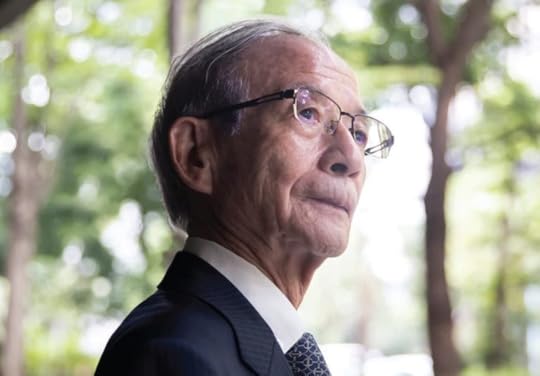 Books by Ikujiro Nonaka
Books by Ikujiro Nonaka SECI, Ba and Leadership: A Unified Model of Dynamic Knowledge Creation
SECI, Ba and Leadership: A Unified Model of Dynamic Knowledge CreationFigure 2.1 Knowledge created through a spiral

Figure 2.4 Creating knowledge with outside constituents

Figure 2.5 Ba as shared context in motion
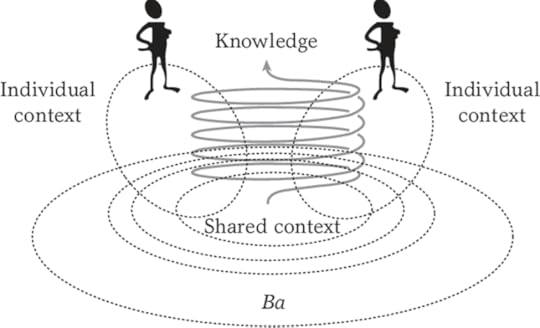
Figure 2.7 Four categories of knowledge asset
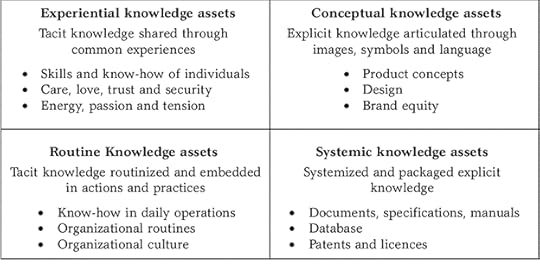 Strategy as Distributed Phronesis
Strategy as Distributed Phronesis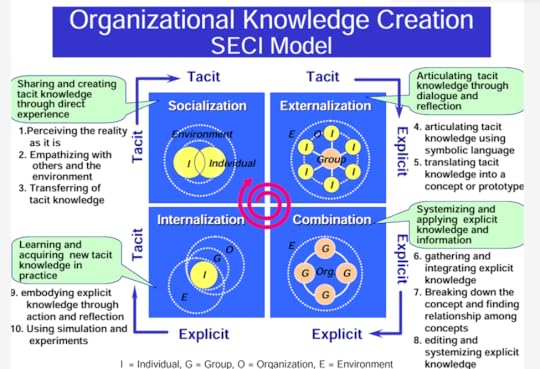
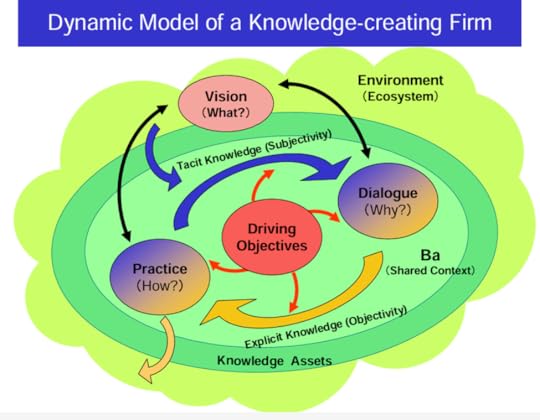 Remembering Ikujiro Nonaka
Remembering Ikujiro NonakaDavid Teece of Berkeley Haas: The breakthrough was his 1994 publication of “A Dynamic Theory of Organizational Knowledge Creation,” in Organization Science, which helped establish the field of knowledge management as a discipline. This was followed in 1995 by a book with his longtime friend and fellow Berkeley PhD Hirotaka Takeuchi, The Knowledge-Creating Company: How Japanese Companies Create the Dynamics of Innovation. These works laid out the model of SECI (Socialization, Externalization, Combination, and Internalization) of how an organization creates benefits from the knowledge within its people only when that knowledge is shared in a spirit of collaboration in a virtuous cycle of collective knowledge creation to be guided by the distinct vision of its managers. While his own presentations tend toward the philosophical, others have been able to operationalize SECI in fields as diverse as information technology and healthcare.
Henry Mintzberg of McGill University: Of Nonaka-san’s many influential publications, my favorite is his article “Toward Middle-Up-Down Management”, not only because it represents so pointedly the spirit of the Japanese approach to management that has had such profound impact on the practice of management in the West, but also because of the playful nature of the title — rare in the eminent journals of academe. Moreover, middle-up-down describes Nonaka-san’s work itself: “down:” his notion that knowledge flows from the experience of individuals; “up:’ carrying that into his general theory of organizational knowledge creation; and “middle:” referring to middle managers — like Nonaka-san himself, guiding the process. Nonaka-san took the initial inspiration of David Teece’s perspective on organizational knowledge and merged it through his own culturally Japanese perspective into a powerful framework of knowledge generation, which he introduced to America and the world.
[image error]July 28, 2025
Communities of Practice in Modern Organizations: Insights on the APQC Survey Report
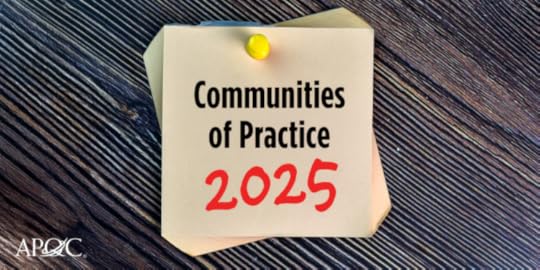
APQC invited me to blog about my insights on their 2025 Communities of Practice in Modern Organizations Survey Report. After reviewing the details in the report, here are my thoughts on the results. In each section, the survey answers are listed first, followed by my comments.
CoP Organizational ModelFormal, functional: CoPs are governed and funded at the level of a single business division/department/functionInformal, functional: CoPs can be started by anyone in the business division/department, but there’s no governance or funding model in placeFormal, enterprise level: CoPs are centrally governed and funded at the level of the entire organizationInformal, enterprise level: CoPs can be started by anyone in the organization, but there is no centralized governance or funding model in placeOnly 23% of participants in the survey reported using number 3 (Formal, enterprise level) — the best choice. The other models result in redundant communities and with communities that fail to span boundaries to connect people across organizations. Funding can come from functions, but governance should be at the enterprise level.
Primary CoP Goals for OrganizationDevelop and disseminate proven practices, guidelines, and proceduresFoster collaboration and sharing across geographiesEnhance networking and professional developmentProvide a forum for day-to-day problem solving and learningInnovate and create breakthrough ideas, knowledge, and practicesEnsure critical knowledge is reused across the organizationIdentify and prioritize areas of critical knowledgeOrganize, manage, and steward bodies of knowledgeThese are all admirable goals. Only 55% reported number 4 (day-to-day problem solving and learning), which should be a fundamental goal for most communities. Number 2 should have the text in bold added:
2. Foster collaboration and sharing across geographies and organizational boundaries
Requirements to Launch a CoP Within OrganizationsIdentify potential participantsAlign to a business priorityCreate a charterSecure key CoP rolesIdentify an agenda and initial topics to coverThere are other important requirements. Before starting a new community, these questions should be answered:
Is there an existing community that covers the topic or a related one?Is the topic defined using widely understood terminology?Are people likely to want to join in sufficient numbers to achieve critical mass (100 or more)? They should identify with it: view themselves as specializing in it.Is the CoP leader willing to spend the time it takes to lead a community?Is the CoP leader willing to measure the community by the established health indicators (e.g., activity and membership)?If the answer to number 1 is “no” and the answers to numbers 2–5 are “yes,” then the new community should be approved. Otherwise, an existing community should be used.
There are five elements that communities need (SMILE):
Subject: A specialty to learn and/or collaborate aboutMembers: People interested in the subjectInteraction: Meetings, calls, and discussionsLeaders: People passionate about the subject who are dedicated to creating, building, and sustaining a communityEnthusiasm: Motivation to engage and spend time collaborating and/or learning about the subject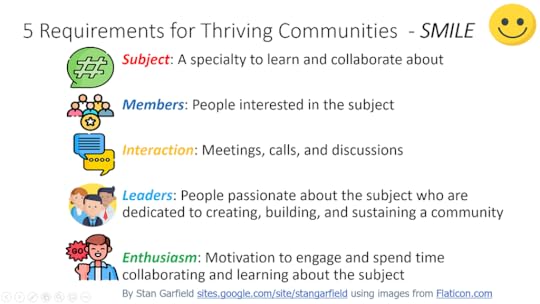 Roles in Place to Support CoP EffortsSubject matter expertsCore group of membersFormal CoP leader(s)Moderator or facilitatorExecutive sponsorContent managerIT support roleLibrarian
Roles in Place to Support CoP EffortsSubject matter expertsCore group of membersFormal CoP leader(s)Moderator or facilitatorExecutive sponsorContent managerIT support roleLibrarianThese are all good roles, and they need not be performed by separate individuals. Communities can succeed with just leaders and members. The leader can also be moderator, facilitator, content manager, IT support, and librarian. The members can be subject matter experts and core members.
Skills and Abilities Most Important for a Successful CoP LeaderPassion for the topicFacilitation skillsActive practitioner within the CoPLeadership abilityChange management and communication skillsRespondents indicated 43% for number 1, 40% for number 2, and 35% for number 3, which are reasonable. All five of these are good for CoP success.
Ways to Encourage/Enable People To Participate in a CoPPromoting a culture that encourages and supports participationCommunicating how it is important to their jobMaking participation a professional development opportunityRewarding and recognizing participationThese two should be added:
5. Setting formal performance goals for participation
6. Setting promotion requirements for active participation
30% reported that their organization does not explicitly provide resources or processes to encourage participation, and only 22% reward and recognize participation. These are disappointing results.
Critical Success Factors Needed to Sustain a CoP ProgramMember engagementCulture of the organizationOrganizational leadership supportAlignment to business objectivesLeadership within CoPs57% chose “member engagement,” but that needs to be better defined. It should not mean that all members need to post to online discussions, but it should mean that all members need to pay attention to community discussions and activities. Using that definition, the number should be close to 100%.
Critical success factors for a communities program include:
A single, global, cross-functional community is available for each major specialty and role.Everyone belongs to at least one community, including the one most relevant to their work.All community members pay attention to the discussions and activities.A single platform, well-suited for communities, is used for all CoPs. For example, in the Microsoft 365 environment, Engage is used, not Teams.There is a single communities directory listing all CoPs and linking to the sites where people can view online discussions and join.For individual communities, they are:
Compelling topic: The members and potential members must be passionate about the subject for collaboration, and it must be relevant to their work.Critical mass of members: You usually need at least 100 members, with 200 being a better target.Committed leader: The community leader should know the subject, have energy for stimulating collaboration, have sufficient time to devote to leadership, and then regularly spend time increasing membership, lining up speakers, hosting calls and meetings, asking and answering questions, and posting information useful to the members.Regular events: Calls or in-person meetings are held regularly.Active online discussions: There are regular posts, multiple replies, and no unanswered questions.Number of Active CoPs in an Organization
1–56–1011–1516–20More than 2035% reported 1–5 communities and 24% reported more than 20. If the former are small organizations and the latter are large ones, these number make sense. The ideal number of communities is exactly one for each topic of importance to the organization and to its people for which there are sufficient numbers of potential members to achieve critical mass.
For small organizations (fewer than 200 people), this could be just one community. For large enterprises, this could be 20 or more. An enterprise should have a smaller number of communities, each with a larger number of members. A single, large community for each important topic, used for collaborating across all organizations and geographies, is more effective than having lots of separate small communities for each possible subset of the topic.
CoP Subject Areas of FocusKnowledge ManagementOperationsIT/DigitalScientific and/or engineering disciplinesResearch and DevelopmentHuman ResourcesSupply ChainFinanceManufacturingMarketing55% reported having a KM community. It’s also good to have a community of community managers to show them how to lead a community and to facilitate sharing and learning by the members.
Here are the types of communities with examples of each (TRAIL):
Topic (e.g., Knowledge Management, Artificial Intelligence)Role (e.g., Project Manager, Community Manager)Audience (e.g., Recruits, Women)Industry (e.g., Manufacturing, Telecommunications) or Client (e.g., European Union, US Federal Government)Location (e.g., Canada, UK) How Employees Get Involved with CoPsVoluntary (open to anyone)Invitation-only (voluntary, expertise needed)Required (assigned, part of performance goals)
How Employees Get Involved with CoPsVoluntary (open to anyone)Invitation-only (voluntary, expertise needed)Required (assigned, part of performance goals)73% reported number 1, which is good. 56% reported number 2, which is not. 30% reported number 3, which is good if it means people are required to join at least one community, but not forced to join a specific one. It’s bad if people are added to communities without their permission.
Communities should be open to anyone and voluntary. It’s desirable to require participation in at least one community, but which ones to join should be up to the potential members, not mandated. No one should be required to join a specific community.
How CoP Members ConnectVirtual meetingsOnline discussion forumFace-to-face meetings88% reported number 1 and 47% reported number 3, which is excellent. But only 67% reported number 2, which is surprising. Online discussions are essential for any community with members in multiple locations. They are also valuable for co-located members because they provide a searchable archive of interactions.
Percentage of Employees Who Actively Participate/Contribute to CoPs0–10%11–25%26–50%51–75%76–90%91–100%For this data to be meaningful, participation needs to be defined, and the data needs to be empirically measurable, not inferred or self-reported. If participation means paying attention to discussions and meetings, then a high percentage of the population is desirable. But getting more than 10% of the population to contribute by posting, speaking, or submitting content is extremely unlikely. Here is the typical breakdown of community participation:
90%: Learn by paying attention but never post9%: Post at least once1%: Post more than onceFor empirical data to support this, see 90–9–1 Rule of Thumb: Fact or Fiction?
Use cases for leveraging AI to enable CoPsEnhancing Knowledge DiscoverySmarter MeetingsContent Creation SupportChatbots and Virtual AssistantsDriving Efficiency Through AutomationSupporting Learning and DevelopmentExperimentation and EvaluationThese are all good use cases. Here are ten more:
Train: Use threaded discussion history to train GenAI chat.Question Answering: AI can respond to queries posted in threaded discussions by searching for previous answers and looking outside the community.Thread Summaries: AI can summarize threads to extract the key points from lengthy discussions.Call Summaries: AI can listen to and summarize community calls for the benefit of those who attended and those who were unable to do so.Mentoring: AI can act as a mentor to community members by advising them based on past discussions, calls, and submitted content.Thread Tagging: AI can tag threads in a consistent manner and add tags not supplied by those posting.Aggregation: AI can monitor activity in multiple communities and aggregate the important content so that it is not missed.Recruitment: AI can find potential members and suggest that they join relevant communities.Moderation: AI can monitor discussions looking for inappropriate language, inflammatory exchanges, and confidential information that should not be discussed, and act promptly to provide the desired remedy.Discovery: AI can find and share relevant external content that members might not otherwise see.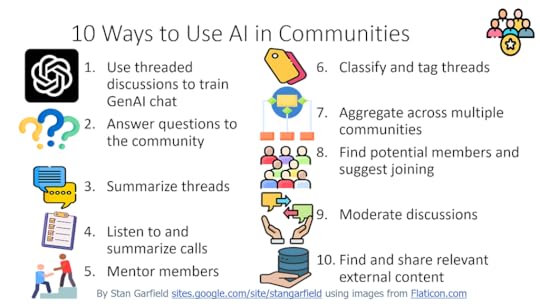 Ways to Reward and Recognize Individuals Who Engage in CoPsPublic recognitionPart of performance reviewNon-monetary rewardsFactors into future promotional decisionMonetary rewards
Ways to Reward and Recognize Individuals Who Engage in CoPsPublic recognitionPart of performance reviewNon-monetary rewardsFactors into future promotional decisionMonetary rewardsThese are all excellent ways. However, 50% reported that their organization does not recognize or reward for participation. If this truly means neither recognition nor reward, then it is alarmingly high. If it means only that there is no reward, then it is more understandable. 35% report public recognition, which is good. The other results are all at 18% and below, leaving much room for improvement.
Here are five additional techniques:
Incentive points tracking (e.g., one point for posting in an online discussion)Competitive rankings (e.g., a leaderboard)Gamification (e.g., reaching higher levels of participation)Digital badging (e.g., community member, community leader, top provider of answers)Percent completion indicator (e.g., joined, subscribed via email, posted, answered a question)Ways to Formally Assess Adoption and Participation in CoPsNumber of attendees at CoP meetings as a percentage of total members or target audienceNumber of contributions (e.g., posts, discussions, replies, content) per time periodNumber of views on CoP sites per time period (i.e., consumption)Number of unique contributions (e.g., posts, discussions, replies, content) per time period38% reported they do not formally assess adoption/participation in CoPs. This needs to be close to zero. Here are additional ways to measure a communities program:
Participation: Percentage of target population that is a member of at least one communityCoverage: Percentage of desired topics covered by a communityHealth: Percentage of communities meeting these criteria (adapt these as necessary):At least one post to an online threaded discussion per weekAt least one call, webinar, or face-to-face meeting per quarterAt least 100 membersNo questions left unanswered after 48 hoursWays to Formally Assess Overall Value of CoPsCoP member satisfaction ratings/survey results per designated time periodNumber of problems/issues solved per time period due to participation in CoPNumber of knowledge assets (e.g., proven practices, lessons learned) produced per CoP per time periodNumber of CoP goals achieved per time period46% reported that they do not formally assess the overall value of our CoPs. This number needs to decrease significantly, and the ways listed above can help. The best way to show the value of communities is by curating anecdotes:
Testimonials by community members on the value of participationStories about the usefulness of the communityPosts thanking other members for their helpResourcesTo hear more insights from me on APQC’s research, register for the August 13, 2025 APQC KM webinar Unlock the Power of Communities of Practice: Research Insights and Expert Perspectives.
Blog: Keys to Starting a Communities ProgramWebinar Recording and Slides: Back to School Edition: Building Effective and Long-lasting Communities of PracticeSIKM Leaders CommunityArticles and Presentations about Communities of Practice and Community Management Handbook of Community Management: A Guide to Leading Communities of Practice [image error]July 25, 2025
Knowledge Management Thought Leader 122: Helen Lippell
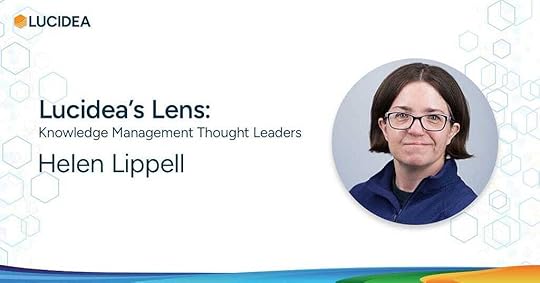
Helen Lippell is a taxonomy, search, metadata, and semantic modeling consultant. She helps organizations sort out their messy content and data.
She is experienced in designing information architectures, metadata schemas, taxonomies, and semantic models to help organizations fully exploit the value of their content. Helen has designed and implemented taxonomies for websites, intranets, content management systems, enterprise search solutions, and semantic publishing tools. She has tamed unstructured data, including financial data, local news, entertainment listings, government information, and operational policing policies.
Helen’s specialties include managing search engines, taxonomy, metadata, content analysis, A-Z indexes, text analysis, search insight, search user experience, findability, information architecture, content audits, categorization, automatic classification, navigation model design, and content modeling. She works on taxonomy development projects, including taxonomy audits, ontology modeling, tagging initiatives, semantic publishing, knowledge graphs, and metadata training. She writes and speaks regularly and is the program chair of Taxonomy Boot Camp London.
Here are definitions for five of Helen’s specialties:
Information Architecture (IA): Organizing, structuring, and labeling content effectively and sustainably to help users find information and complete tasks. IA helps users understand where they are, what they’ve found, what’s around, and what to expect. Metadata : Information about information — data fields added to documents, sites, files, or lists that allow related items to be listed, searched for, navigated to, syndicated, and collected.Ontology: A set of concepts and categories in a subject area or domain that shows their properties and the relations between them. Search Engines : Tools that allow searching for sites, documents, files, list items, content, answers to questions, and other digital information. They allow specifying the scope or domain of the search, whether to search on text, images, or metadata, and how results should be presented. Taxonomy : A particular classification arranged in a hierarchical structure that can be used to organize information so that it can be readily found through navigation, search, and links between related content.Helen created the following content. I have curated it to represent her contributions to the field. For more about Helen, see Profiles in Knowledge.
 Books by Helen Lippell
Books by Helen Lippell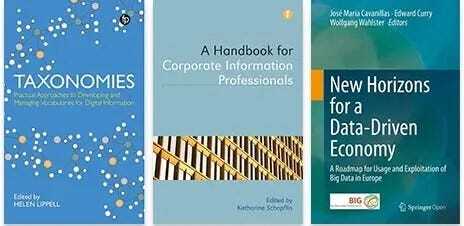 The ABCs of the BBC: A Case Study and Checklist
The ABCs of the BBC: A Case Study and ChecklistEight-point checklist for creating terrific A-Z indexes
Know your audience: It’s vital to understand the way that your audience interacts with your website and your index. There are many ways of doing this; three that can be particularly useful are search log analysis, persona development, and user testing. Search logs have been invaluable throughout the lifecycle of the A-Z to highlight the areas of interest to users. They also shed light on the language used by people trying to find things on the site. Even though the A-Z is a browse tool and search is a search tool, don’t ignore the common goals of their respective users: finding stuff easily.Show your numbers: Don’t make your users guess: even if there’s only one non-alphabetic entry, show that it exists. Many indexes fudge the challenge of entries that begin with numerals by shoving them, for example, in under ”A” or “Z.” Chances are, the entries will only ever be found by serendipitous browsing or lucky guessing. Whatever it is labeled, make the numbers section or page prominent by placing it in front of the letter “A.” This is a convention in computer books that index technical concepts.Acknowledge articles: The question of how to deal with entries that start with “the,” “a,” or “an” became important for bbc.co.uk because of the sheer volume of program titles that needed to be added to the index. Eventually we decided to double-post entries under both the first letter of the article word and whatever letter the next word started with, hence entries for both “The Apprentice” and “Apprentice, The”. As with the previous tip, why make users stop to think about how the indexer might choose to see the content? The beauty of an A-Z over a directory or a sitemap is that different mental models can be supported and the same thing can appear in more than one place. This gives it an advantage over, say, the Grand Vizier’s camels.Include synonyms: Synonyms, in the form of “See: XX” references, appear throughout the bbc.co.uk index. As in the traditional thesaurus, they are used to show equivalence between a word or phrase and its preferred term. Synonyms in an A-Z add richness to the list of entries–and can often allow you to speak your users’ language without losing the ability to call entries by their correct names. Equally, synonyms play a role in educating users as to what those correct names are. For bbc.co.uk, many synonyms are used in the A-Z to provide alternative access paths to branded content. For example, the radio station Five Live is always written with a word rather than a number, but a user scrolling through the numbers page will see a pointer to it.Properly index proper names: People should be indexed by surname rather than first name, as per book indexing convention. There are of course some exceptions; for example, the names of monarchs (“Charles I”), certain celebrities (“Mel B”), or people from cultures where the surname appears before the first name (“Mao Tse-Tung”).Consider your cross-references: In general, the bbc.co.uk A-Z avoids excessive cross-referencing, which could make already long pages less usable and less attractive to casual browsers. However, bringing closely related concepts together can add value to the index and promote content in different places. Cross-references are shown as “See Also:” pointers in entries, such as a country name linked to content about the languages that are spoken there.Use qualifiers and extra information: Besides synonyms and cross-references, there are other ways to make your index more user-friendly. Qualifiers are extra bits of information in parentheses, attached to index entries, often for clarifying concepts. For example, the bbc.co.uk A-Z qualifies dance as “(Performing Art)” in order to differentiate it from dance music, which is also covered in depth on the site.Take pride in the index: Dealing with everything mentioned in the other seven tips will give your index a fighting chance of being successful. None of it will matter, however, if users cannot find it. Make the A-Z index available from all parts of your site if you can, preferably linking to it in a consistent, prominent place on every page. This might be in a toolbar or as part of the navigation. Whatever you do, don’t follow the example of some sites that put the link to the A-Z at the bottom of the page, in tiny size 1 font, with other links that very few people (apart from lawyers) ever see, let alone click on.Storyline OntologyThe News Storyline Ontology is a generic model for describing and organizing the stories news organizations tell. The ontology is intended to be flexible to support any given news or media publisher’s approach to handling news stories. At the heart of the ontology, is the concept of Storyline. As a nuance of the English language the word ‘story’ has multiple meanings. In news organizations, a story can be an individual piece of content, such as an article or news report. It can also be the editorial view on events occurring in the world.
The journalist pulls together information, facts, opinion, quotes, and data to explain the significance of world events and their context to create a narrative. The event is an award being received; the story is the triumph over adversity and personal tragedy of the victor leading up to receiving the reward (and the inevitable fall from grace due to drugs and sexual peccadillos). Or, the event is a bombing outside a building; the story is an escalating civil war or a gas mains fault due to cost cutting. To avoid this confusion, the term Storyline has been used to remove the ambiguity between the piece of creative work (the written article) and the editorial perspective on events.
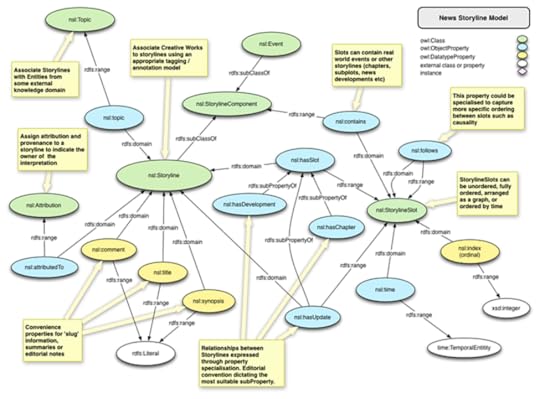 How I use the principles of KM to build high-quality semantic products for organization
How I use the principles of KM to build high-quality semantic products for organizationFive short case studies using The Five Cs of KM.
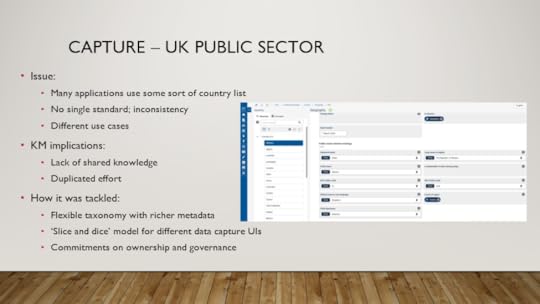

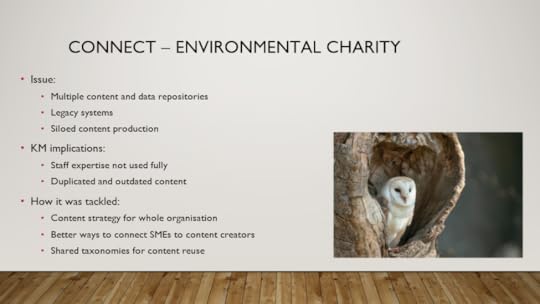

 [image error]
[image error]
July 23, 2025
Badou Bousso: Profiles in Knowledge — Rising Stars Series

This is the 117th article in the Profiles in Knowledge series featuring thought leaders in knowledge management and the third in the Rising Stars Series. Rachel Teague suggested this series and is my co-author on this article.
Badou Bousso is a knowledge architect, content manager, language engineer, and communications professional. He has expertise in designing KM solutions and improving business processes. Badou has established himself as a thought leader in knowledge management, specializing in knowledge capture and transfer, knowledge base design, content management, productivity tool management, and AI stewardship. He has the ability to harness the power of knowledge to drive organizational success.
Beyond knowledge management, Badou is a dedicated communications professional. He is an adept translator, editor, and educator, bringing clarity and precision to every project he undertakes. With experience in the healthcare and non-profit sectors, he has developed a deep understanding of the unique challenges and opportunities within these industries.
Background RolesEditor & Translator: translation, proofing, editing, localization, transcriptionContent specialistCommunications specialistLanguage instructorCustomer service professionalOther Areas of Interest and ExpertiseDocuments in multilingual contextDesktop PublishingCultural Awareness, InternationalizationLiterary CriticismCulture StudiesLanguages: English, French, Spanish, Wolof, Arabic (functional)EducationThe University of Kansas — Ph.D. Candidate, Francophone Studies, 2005–2008Kent State University — Master of Arts, Translation, 2002–2004University of Wisconsin-Madison — Exchange Year, 2001–2002Université Gaston Berger de Saint-Louis — Bachelor of Arts, Applied Linguistics, 1997–2001ExperienceThe Canadian Medical Protective AssociationKnowledge Manager, 2023 — PresentContent Management Coordinator, 2020–2023uOttawa Professional Development Institute — Instructor, 2021 — PresentCross-Cultural Coach — Freelance, 2006 — PresentLanguage Entrepreneur — Freelance, 2003 — PresentThe Canadian Nurses Protective Society (CNPS) — Editor and Chief Translator, 2015–2019The Canadian Medical Protective Association — Publications Coordinator, 2010–2015College Platon — Language Instructor, 2008–2010KJHK 90.7 FM — Radio Host, 2007–2008Other ActivitiesChair of Editors Ottawa-Gatineau (since 2024)Chair of the Editors Canada’s Francophone Conference (2024)ProfilesLinkedInTwitterBlueskyFacebookEditors CanadaCapital LettersOutschoolContentConnectique: Personal Substack — future site for publishing a catalog of pieces on KM foundations, business process improvement, language engineering, AI, etc. Currently working on a series of articles dubbed KM in Multicultural Contexts.KM in Customer ServiceLinkedIn PostsWhat knowledge management is about
RolesEditor & Translator: translation, proofing, editing, localization, transcriptionContent specialistCommunications specialistLanguage instructorCustomer service professionalOther Areas of Interest and ExpertiseDocuments in multilingual contextDesktop PublishingCultural Awareness, InternationalizationLiterary CriticismCulture StudiesLanguages: English, French, Spanish, Wolof, Arabic (functional)EducationThe University of Kansas — Ph.D. Candidate, Francophone Studies, 2005–2008Kent State University — Master of Arts, Translation, 2002–2004University of Wisconsin-Madison — Exchange Year, 2001–2002Université Gaston Berger de Saint-Louis — Bachelor of Arts, Applied Linguistics, 1997–2001ExperienceThe Canadian Medical Protective AssociationKnowledge Manager, 2023 — PresentContent Management Coordinator, 2020–2023uOttawa Professional Development Institute — Instructor, 2021 — PresentCross-Cultural Coach — Freelance, 2006 — PresentLanguage Entrepreneur — Freelance, 2003 — PresentThe Canadian Nurses Protective Society (CNPS) — Editor and Chief Translator, 2015–2019The Canadian Medical Protective Association — Publications Coordinator, 2010–2015College Platon — Language Instructor, 2008–2010KJHK 90.7 FM — Radio Host, 2007–2008Other ActivitiesChair of Editors Ottawa-Gatineau (since 2024)Chair of the Editors Canada’s Francophone Conference (2024)ProfilesLinkedInTwitterBlueskyFacebookEditors CanadaCapital LettersOutschoolContentConnectique: Personal Substack — future site for publishing a catalog of pieces on KM foundations, business process improvement, language engineering, AI, etc. Currently working on a series of articles dubbed KM in Multicultural Contexts.KM in Customer ServiceLinkedIn PostsWhat knowledge management is aboutKnowledge management (KM) is about translating experience into actionable knowledge:
Turning implicit knowledge into explicit knowledgeBringing ideas to lifeCapturing know-howIdentifying needs and resourcesOffering simple solutionsIn the end, KM is about recording experience as it unfolds. But you have to do it methodically:
CollectConnectVetDisseminatePresentations and CoursesPairUpWebinar (October 9, 2025) Personal Knowledge ManagementWebinar (September 25, 2024) Capturing Tacit Knowledge: Strategies for Preserving Expertisehttps://medium.com/media/894d93a008513c803511662926dacaf1/href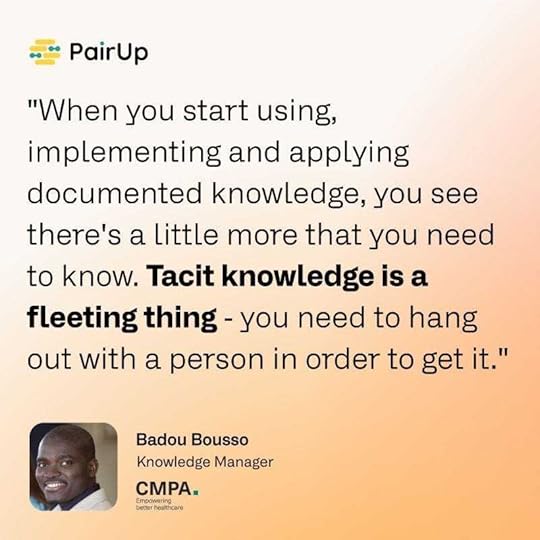 APQC
APQC1. Conference Breakout (May 1, 2024) How a Robust Content Management System Enhances Customer Experience


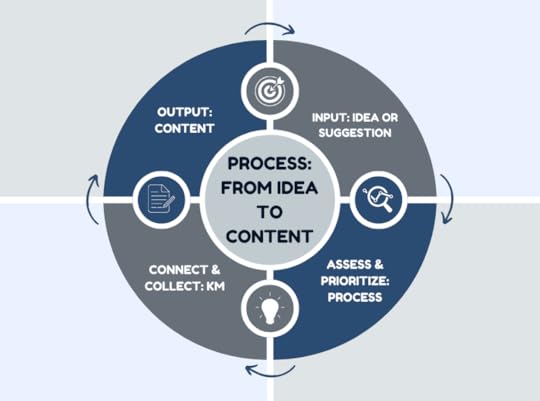
2. Webinar (June 11, 2025) AI in Action: Transforming Knowledge Capture and Retrieval
— Details
— Slides
https://medium.com/media/8556f35099b57bacec380cc873ddc6ec/href
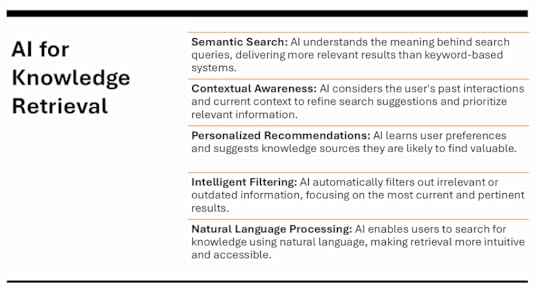
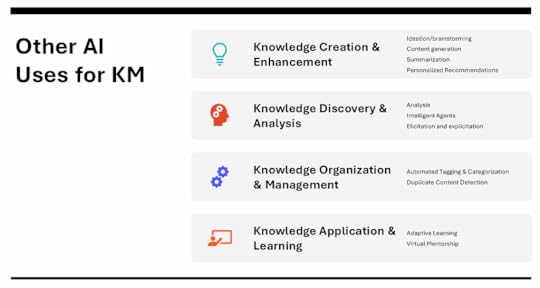
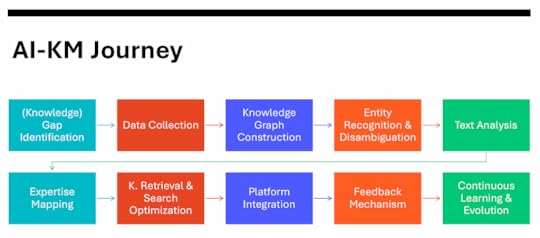 Editors Ottawa-GatineauRoundtable (January 15, 2025) Introduction to Prompt Engineering for EditorsPresentation (February 15, 2023) Speaker Night: Multilingual EditingTraining (May 15 & 22, 2024) Revising a translation: quality in fidelityEditors Canada Francophone Conference (November 28, 2024) La façon de communiquer vaut mieux que ce qu’on communique: L’art de la rétroaction efficace (How you communicate is better than what you communicate: The art of effective feedback)University of Ottawa Professional Development InstituteCourse: Knowledge Management — An IntroductionCourse: Knowledge Management — Advanced PracticesCourse: Harnessing AI for Smarter Knowledge ManagementCourse: The Basics of Business WritingThe July 2025 Rising Star Interview by Rachel Teague
Editors Ottawa-GatineauRoundtable (January 15, 2025) Introduction to Prompt Engineering for EditorsPresentation (February 15, 2023) Speaker Night: Multilingual EditingTraining (May 15 & 22, 2024) Revising a translation: quality in fidelityEditors Canada Francophone Conference (November 28, 2024) La façon de communiquer vaut mieux que ce qu’on communique: L’art de la rétroaction efficace (How you communicate is better than what you communicate: The art of effective feedback)University of Ottawa Professional Development InstituteCourse: Knowledge Management — An IntroductionCourse: Knowledge Management — Advanced PracticesCourse: Harnessing AI for Smarter Knowledge ManagementCourse: The Basics of Business WritingThe July 2025 Rising Star Interview by Rachel TeagueI first crossed paths with Badou Bousso at the 2024 APQC KM Conference, where we were both speakers. Although we only met briefly in passing, I remember being intrigued by his session on How a Robust Content Management System Enhances Customer Experience. Our paths crossed again that December during a virtual Knowledge Transfer Certification Program, also through APQC, where we ended up in the same project group.
Despite our different professional backgrounds, I found myself genuinely drawn to Badou’s perspective. He has a way of approaching knowledge work that is both thoughtful and energizing. I loved his positive outlook, his deep respect for people and culture, and the way his journey has brought him to the intersection of people, process, and systems.
Getting to know Badou more deeply through this interview was an absolute pleasure and only confirmed what I sensed from the beginning: he’s someone worth learning with and from.
What led you into the field of KM, and why are you passionate about it?I came to the field of KM naturally, unbeknownst to me. While pursuing my master’s degree in translation at Kent State University, I did a project on knowledge organization. We were tasked with picking a topic and organizing the knowledge that came from it in terms of primary, secondary, and tertiary sources. I picked international trade and spent a couple of weeks diving into it — researching, analyzing, and documenting sources. Dr. Françoise Massardier-Kenny, Emeritus Professor of Translation at Kent State, had high praise for the work I did. More importantly, I felt something special: I genuinely enjoyed digging up knowledge, categorizing it, organizing it, and sharing it. Little did I know at the time (2003) that Kent State was — and would continue to be — a premier institution for KM learning.
Fast forward a few years: after a stint in academia as a Ph.D. candidate at the University of Kansas (KU), I moved to Canada and began working in the corporate world as a policies and publications coordinator. I was instantly thrust into a world I really liked, a “sweet spot,” as one of my people leaders would later call it: language, communications, research, and knowledge work. That role led me to dive deeper into the field of knowledge management, and in 2011, I became a Certified Knowledge Manager (CKM) through KMI and KMIC. I came back from that certification emboldened, inspired, and excited to start talking the talk and walking the walk. It turned into a grassroots effort — one where I made a conscious move to embed KM in everything I do, including recruiting and mentoring others into KM without them always realizing it at first.
My time at KU was instrumental in shaping how I think, reason, and communicate. I’m indebted to my professors there for instilling in me academic rigor, high standards in research, writing, and elocution. My doctoral experience also introduced me to critical methods, particularly how to examine arguments through both logic and context. For an argument to hold water, it must be grounded in a valid approach and a solid set of facts. That critical thinking framework has become indispensable in my KM work, where validity, evidence, and clarity matter deeply.
I view my eclectic background not as a coincidence but as an asset. It’s the intersectionality of my areas of interest that turbocharges my drive to make a difference in KM. Translation, for example, is one of the last-standing polymathic disciplines. It requires a confluence of other domain languages, linguistics, sociolinguistics, culture, technology, research, and content management. Each one has helped shape my KM philosophy.
Growing up in Senegal, I was immersed in a culture where oral transmission of knowledge was — and still is — a powerful and respected tradition. That experience left a deep imprint on me. My father used to say, “You need to know what you’ve not been told” — a mindset that emphasized listening, observing, and interpreting the unspoken. It’s something I’ve carried with me throughout my work as a communicator, translator, and knowledge professional. Today, I see oral and tacit knowledge as critical, especially in cultures and communities where nonverbal communication is just as important as written documentation.
In that sense, KM doesn’t just align with my passions — it’s the place where all of them converge. Language, culture, process improvement, education, communication, and content — they all collide in KM. It feels like home.
What are your specialties?Everything I do in the KM space revolves around people, process and technology. I call them the trivium of knowledge management. I view them as the foundation of any KM specialties. More specifically, I like focusing on the following:
KM strategy: I often tell my KM students that strategy is the backbone of KM, not that they should have a written strategy per se but that they are themselves the strategy.Knowledge Sharing & Collaboration: Whether through communities of practice, mentoring, or day-to-day interactions, I prioritize getting the right knowledge to the right people at the right time.Innovation: Delivering solutions that support our KM vision, which includes leveraging technology to develop and manage knowledge bases, communities, knowledge transfer, etc.Content Management & Governance: Content, in all its formats, is the explicit manifestation of knowledge. I have deep experience in organizing, governing, and optimizing content to support knowledge flow.Business process improvement: Continuous improvement is one of the key goals of knowledge management. It is achieved through effective process management. KMers must not only get involved in mapping and refining processes, but also help identify knowledge gaps, reduce duplication, and ensure that critical insights are captured and shared at every step.Knowledge transfer and continuity planning: As a KMer, I take it upon myself to not let expert knowledge walk out the door. How so? I’ve been designing proactive approaches from employee onboarding to offboarding such as mentoring, reverse mentoring, communities of practices, etc. Organizations spend millions on hiring talent and building expertise. Subject matter experts not only carry critical knowledge, but they harbor organizational business intelligence. Therefore, preventing the loss of such invaluable knowledge is paramount. Similarly, I spend a lot of time working on surfacing tacit knowledge. We know that roughly 80% of people’s knowledge is in their heads (tacit), and we only have access to the remaining 20% (explicit).KM education: I actively teach and develop courses at the University of Ottawa’s Professional Development Institute (PDI), including “Intro to KM” and a new course on AI & KM. I see education as both a KM practice and a passion. It’s about spreading the word and preparing the next generation of practitioners while evolving the field itself.Who are your influences and why?I have so many influences, probably because of my eclectic background. I operate from a wide range of influences, some academic, some linguistic, some purely KM. My knack for knowledge-based research and knowledge organization started in graduate school. I credit the Kent State Institute for Applied Linguistics (IAL) for preparing and opening me up to a whole world of possibilities.
Likewise, early in my career, I was guided by people leaders who understood the necessity for KM, and they did so through their sponsorship and mentorship, which helped me develop thought leadership skills.
The global KM community has been a huge influence from organizations like KMI and APQC to associations and individuals. Naturally, I have to give props to the sages of KM as I like referring to them: Doug Weidner, Stan Garfield, and Cindy Hubert, among others. I’ve learned so much by simply watching these folks share their wisdom in community forums, online discussions, and conferences. It’s amazing to see leaders like Stan and Doug jump in with guidance and insight — it’s a real-time masterclass.
I also owe a lot to my early education and upbringing. My parents raised me to be open, curious, and deeply respectful of other cultures and ways of thinking. In high school, some of my most influential teachers introduced me to the concept of universalism, which sparked my desire to understand the world. Before I ever traveled internationally, I had already started exploring it intellectually and that spirit of exploration never left me.
African culture has been a huge inspiration, specifically how knowledge is transferred, mainly orally and through tacit means. From a young age, you’re taught to observe, internalize and apply. I partly grew up in this culture that valued oral transmission of knowledge and emphasized the importance of memorization. To learn, you need to listen, and it’s through that process that you retain. It’s a combination of active listening, deductive listening, and retentive listening. Oral tradition has one major advantage: memorization. It’s interesting that we’re losing that function now. Human societies traditionally excelled at it. Non-verbal communication is central to the process.
This cultural lens also shapes how I approach sociolinguistics — how people express themselves based on setting, personality, or background. I’m always observing communication styles, accents, cues, and nonverbal indicators. These insights help me tailor how I engage with people. I see this not only as a communication tool but as a KM practice, especially when working across cultures or disciplines. Ultimately, I see KM professionals as connectors — people who help surface commonalities and build bridges across differences. That belief shapes both my practice and my teaching.
If you could only implement one component as part of a KM program, what would it be, and why?This question can be difficult to answer given the broad nature of our field, but if I have to choose one, it would be “culture and values.” I consider them foundational for any KM program. I actually believe there’s no KM without a deep appreciation for culture and values. They are the platform on which KM operates.
KM, at its core, is about connecting people by helping them connect the dots. That’s how you institute a culture of learning and collaboration, which ultimately creates value over and over again. Consequently, to connect people, you need to know what animates them, how they relate to one another, how they like to learn, what perceptions they have, what motivates them, and a whole array of realities that will end up forming the principles upon which the program is founded.
So culture is at the core of any successful KM program. I call it the undercurrent, because it’s rarely exposed but it powers everything else. It’s not something that just happens organically; you have to intentionally create the right environment. You have to earn it, nurture it, and protect it. Without the right culture, people won’t share, collaborate, or innovate.
In my experience, culture is what makes other KM components possible such as knowledge sharing, collaboration, or even technology adoption. You can have the best tools or processes in place, but if the culture isn’t ready, none of it will stick. I often describe KM professionals as the glue that connects departments, people, and perspectives. To be effective, you need to tap into people’s commonalities and shared struggles. That’s where trust and empathy emerge and that’s where KM truly thrives.
What is your vision for a successful KM program?I articulate my vision around the following:
A successful KM program has to start with developing the right culture, a culture that is conducive to knowledge sharing, learning and collaboration. Without the right culture, you can’t sustain any of the other components. You cannot innovate, build community, or drive process improvement unless people feel safe, valued, and motivated to share.
This is what learning organizations are built on, which is what fuels people to interact, exchange, and create. KM becomes the undercurrent that allows these things to flourish — not always visible, but always essential.
In simple terms, my vision for a successful KM program is one that creates an environment where people and dots can be connected, and where knowledge can move fluidly across silos, functions, and cultural boundaries. It’s about making space for shared understanding to emerge.
Technology can play a role, of course, but only as an enabler. The heart of KM is human. A successful program recognizes that and empowers people to become knowledge stewards in their own right — even before they realize they’re doing KM.
What are you most proud of in your career so far?Bringing knowledge management to the fore and giving it its due, i.e., taking it from an afterthought to a force to reckon with. I was able to do this through various means:
Insert KM into the conversationCreate teachable momentsConnect people and dotsHave a proactive approach to changeOne of the things I’m most proud of is building the very first knowledge base in our company. At the time, I didn’t even have “KM” in my title, but I knew what we were doing was knowledge work. I started developing the structure, building out processes, and engaging others quietly but steadily. When I completed my CKM certification in 2011, I finally had the validation I needed. I came back and said, “Here’s why this approach works — and here’s how we keep going.”
What began as a small project turned into a grassroots movement. I started enlisting leaders and colleagues — not by imposing a KM framework, but by showing how it helped their work. Many of them didn’t realize they were doing KM until much later. That’s the beauty of it. I’m still doing that today: embedding KM where it fits naturally, empowering others, and building momentum one conversation at a time.
What would you like to accomplish in the short term and long term?Short Term: I want to continue finding effective ways to navigate artificial intelligence (AI) in KM. I’ve been actively exploring knowledge architecture and using tools like WebProtégé to build taxonomies and knowledge graphs. I’m also learning how to structure content to be AI-ready so it can be surfaced more effectively in AI-powered search tools like Perplexity. I’m using AI not just as a tool, but as a coach, to accelerate learning and push my thinking.
I’m also deeply interested in helping others understand how to adopt AI responsibly. As KM practitioners, we need to slow down the rush to implement and ask foundational questions. What’s the actual problem we’re trying to solve? Do we have the right people and processes in place? If not, the technology alone won’t work. This is where traditional KM plays a critical role.
Long Term: I want to be part of the movement to future-proof traditional KM. With technological advances, there’s a growing sentiment that everything revolves around tech — but we know that’s not sustainable. KM has always been about people, process, and technology — in that order. The principles we’ve relied on for decades — knowledge capture, storytelling, collaboration, learning culture — aren’t going out of style. If anything, they’re becoming more essential as complexity increases.
I believe in responsible KM and evidence-based KM, rooted in time-tested principles. Those principles — human-centered, ethical, inclusive — will be our compass. AI may change how we work, but it shouldn’t change who we are.
What are your top three knowledge nuggets/insights/lessons learned?Knowledge: Use it or lose it. Knowledge that isn’t shared, applied, or revisited is at risk of disappearing. Whether it’s tacit knowledge held in someone’s head or formal content stored in a system, it needs to be activated regularly to stay alive and relevant. This is especially true for organizations — if you’re not intentional about surfacing and reusing knowledge, you’ll lose it when people leave, or systems change.People, process, and technology — with culture as the undercurrent. The classic KM triad still holds, but it doesn’t work without the right culture. Culture is the invisible current that makes everything else possible. You can have the best processes and the flashiest tech, but if the culture doesn’t support sharing and collaboration, it all falls flat.Responsible AI must be rooted in traditional KM principles. AI is exciting and powerful, but it needs to be grounded in ethics, intent, and human-centered design. I believe KM gives us the frameworks we need — like change management, taxonomy, and content governance — to implement AI in ways that actually help people rather than overwhelm or replace them.What is something in the KM space you would like to learn more about?I’m very passionate about knowledge architecture and knowledge graphs right now and eager to learn more about them. I was an early adopter of information architecture in my KM practice, and that foundation has really helped me as I move into the next phase. I think it’s pretty clear by now that future KM systems will be AI-powered. Knowledge architecture is poised to be the backbone of any AI-powered solution, which also puts knowledge management in a unique position.
I’ve been learning tools like WebProtégé, developed by Stanford, to model taxonomies and ontologies. I’ve even used AI as a coach along the way, and it’s been amazing to get real-time feedback while experimenting.
I just think the ability to visualize knowledge helps identify patterns, connections, and gaps, but more important, it helps both humans and machines surface it more easily. We’re also exploring how this applies to search engine optimization (SEO), since more people are now searching through generative AI platforms. Making content AI-ready is part of making it usable and findable. It’s really exciting!
[image error]July 17, 2025
Knowledge Management Thought Leader 121: Euan Semple

Euan Semple has been a leader and influencer in the ever-changing field of digital technology for three decades. An early adopter of social media, he implemented one of the first enterprise social network (ESN) systems inside the BBC. He also ran BBC DigiLab, a department whose purpose was to help the BBC understand new technologies across the range of its activities and make better decisions about their use and implementation.
Euan left the BBC in 2006 to establish his own consultancy and help clients stretch their thinking about digital transformation in all its forms — and to ensure that they end up doing the right things for the right reasons.
His specialties include knowledge management, social computing, blockchain, artificial intelligence, automation, informal learning, weblogs, wikis, forums, social networking applications, social business, culture change, leadership, communication, intranets, ESNs, internal communications, and public relations.
Here are definitions for five of Euan’s specialties:
Blogs : Websites where posts are made (such as entries in a journal or diary), displayed in a reverse chronological order. Often provide commentary or news on a particular subject. Some function as personal online diaries or logbooks. Combine text, images, and links to other blogs and websites. Typically provide archives in calendar form, local search, syndication feeds, reader comment posting, trackback links from other blogs, blogroll links to other recommended blogs, and categories of posts tagged for retrieval by topic. Enterprise Social Networks : Internal, private social networking platforms used for communications and collaboration within an organization. Threaded Discussions: tools for carrying on conversations among community members on a specific subject, including online and email posts and replies, searchable archives, and discussions grouped by threads to show the complete history on each topic. Intranets : Private computer networks that use Internet protocols, network connectivity, and the public telecommunication system to securely share part of an organization’s information or operations with its employees. Social Business : The use of Enterprise Social Networks, blogs, wikis, video sharing sites, podcasts, mashups, tags, tag clouds, pins, ratings, and folksonomies within an enterprise. Wikis : Websites that allow any user to easily add, remove, edit, and change most available content. Wikis are effective for collaborative writing, self-service web page creation, and shared maintenance of information. Anyone can edit a wiki page; links and new pages are automatically generated, and there is a revision history that lists all previous versions, with the ability to undo changes and revert to a prior version.Euan created the following content. I have curated it to represent his contributions to the field. For more about Euan, see Profiles in Knowledge.
Books by Euan Semple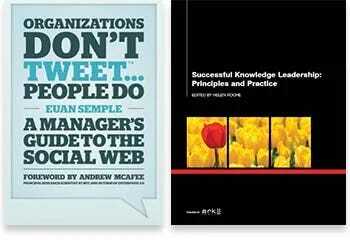 The Power of Networks: A Conversation with Euan Semple
The Power of Networks: A Conversation with Euan SempleEuan partnered with Lucidea for this KM classic: The New Knowledge Ecosystem: Content and Connection. It’s an oldie that holds a lot of its value. Watch the recording to see for yourself!
 The Three Cs
The Three CsI recently wrote a post about the potential for systems to be self-organizing and the way that we compromise this ability by attempting to exercise control over the world around us. In order for systems to become self-organizing the networks that make them up have to be comprised of healthy cells. It occurred to me that in order to become healthy the cells need to be encouraged to work on the following three characteristics.
1. Curiosity: Wondering why things are the way they are. A willingness to relax their grip on fixed ideas and to consider alternatives. An inclination to tinker. This is what allows kids to adopt new technology so quickly. We have driven curiosity and playfulness out of the workplace in our attempts to be “businesslike” and in the process have compromised our collective ability to adapt and be effective.
2. Critical thinking: Constantly thinking about where information is coming from, who are its sources, and who has vested interests in its propagation. Working out the likely truth of the things we consume measured against our other experiences and with a healthily skeptical attitude. Considering the consequences of onward sharing of the information we take in.
3. Conversation: Adopting a more conversational tone in how we share ideas and discuss the world around us. Avoiding dogma and dogmatic attitudes. Engaging in a to and fro with equals. Recognizing that we are conversing with another human being who shares our challenges and is also struggling to make sense of the world. This last principal needs to be applied just as much online as off.
These three Cs are just as important as the traditional three Rs and we should consider teaching them in school.
Social Networks are All About Finding StuffA question from Dave Snowden (“In your opinion, what’s the best tool for semantic search and representation?”) about what I thought the best semantic search tool was and my rather facetious response “the meatware” reminded me of something I am more and more convinced of. Social networks are about finding stuff. Finding documents, finding people, even finding human contact.
I have often said that the best search engine is other people’s collective memory. When people ask on a forum where to find a previous answer tell them to ask the question again. Users will almost certainly remember the question being asked and will point to the previous answer. If you are lucky, and ask the question well, you may even get pointers to various answers any or all of which could be useful. If you are really lucky you will kick off new exploration of the subject and unearth new and more current information.
Social media is making this ubiquitous access to an outboard brain more obvious to more people and there has even been talk of it replacing Google for some. The point is you can only do this if you have a high quality network of people doing the filtering and collective noticing for you. Building up these networks, and building “credit” by helping others, will become key skills and the people who invest the effort will find the better stuff faster.
Ten Ways to Create a Knowledge EcologyA tweet yesterday prompted me to remember sage advice from Dave Snowden which I took to heart in my work with social tools at the BBC. “You can’t manage knowledge but you can create a knowledge ecology”. I thought it might be useful to others to list the ten most important things I learned about doing this.
Have a variety of tools rather than a single system. Not everyone sees the world the same way or has the same needs so mixing up different tools with different strengths allows people to find one that works for them. Avoid single platforms like the plague.Don’t have a clear idea where you are headed. The more fixed you are in your aspirations for your ecology the less likely you are to achieve them. Be prepared to go where people’s use of the tools takes you and enjoy the ride.Follow the energy. Watch where the energy in the system is and try to copy the factors that generated it. Get others interested in why energy emerges and they will want some of it themselves.Be strategically tactical. You can have an overall strategy of behaving in certain ways depending on how your ecology develops. It is possible to sell this as a strategy to those who need strategies.Keep moving, stay in touch, and head for the high ground. Keep doing things, keep talking about what you are doing and why, and have a rough idea of where the high ground is.Build networks of people who care. Don’t try to manage your ecology by committee but cultivate communication and trust between those who care that it works and have the commitment to do something about it — whoever they are and whatever their role.Be obsessively interested. Notice everything that happens and consider why. Tell great stories about what you are observing.Use the tools to manage the tools. Blog about what is going on with your corporate blogging, ask questions in your forum about security, tweet when something is changing in your ecology and ask people why it is interesting.Laugh when things go wrong. If you are pushing limits and exploring new territory things will occasionally blow up in your face. Having a sense of humour and enjoyment of the absurd will help you stay sane.Unleash Trojan Mice. Don’t do big things or spend loads of money. Set small, nimble things running and see where they head.[image error]


